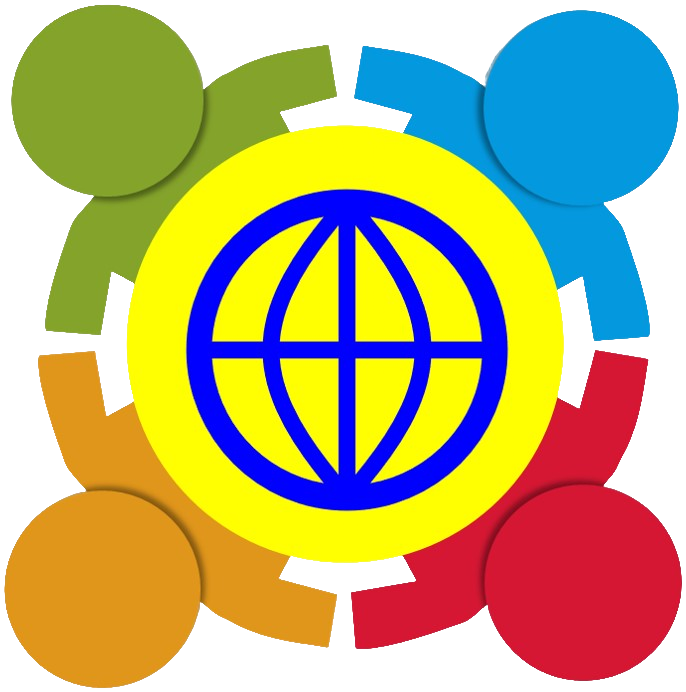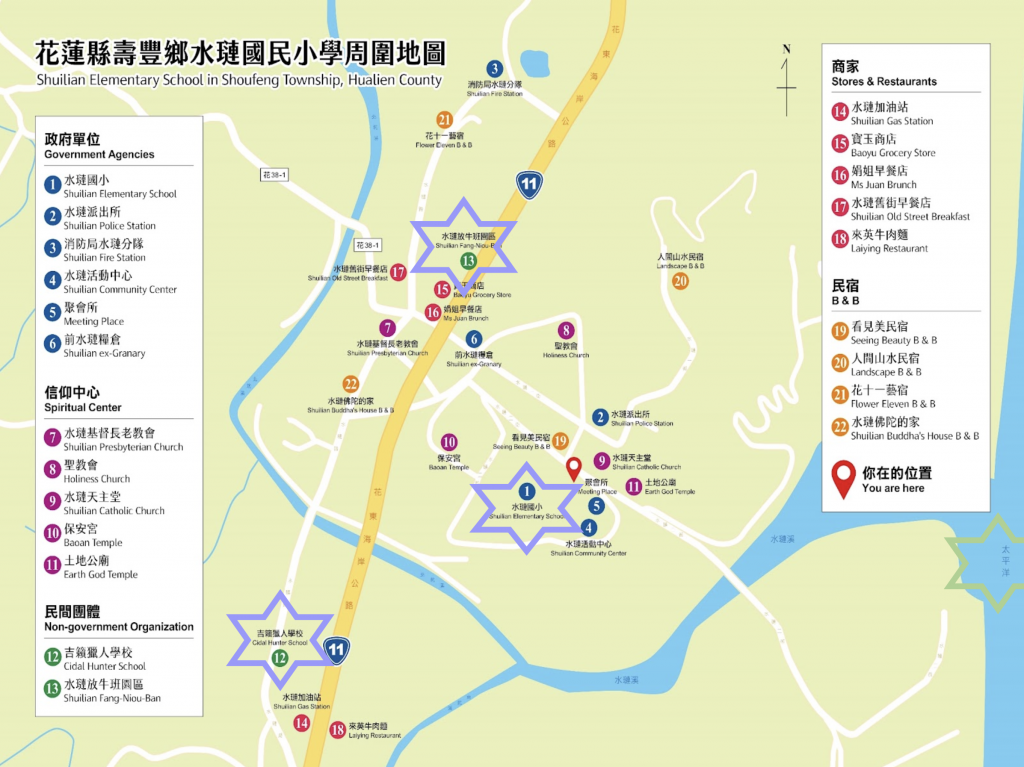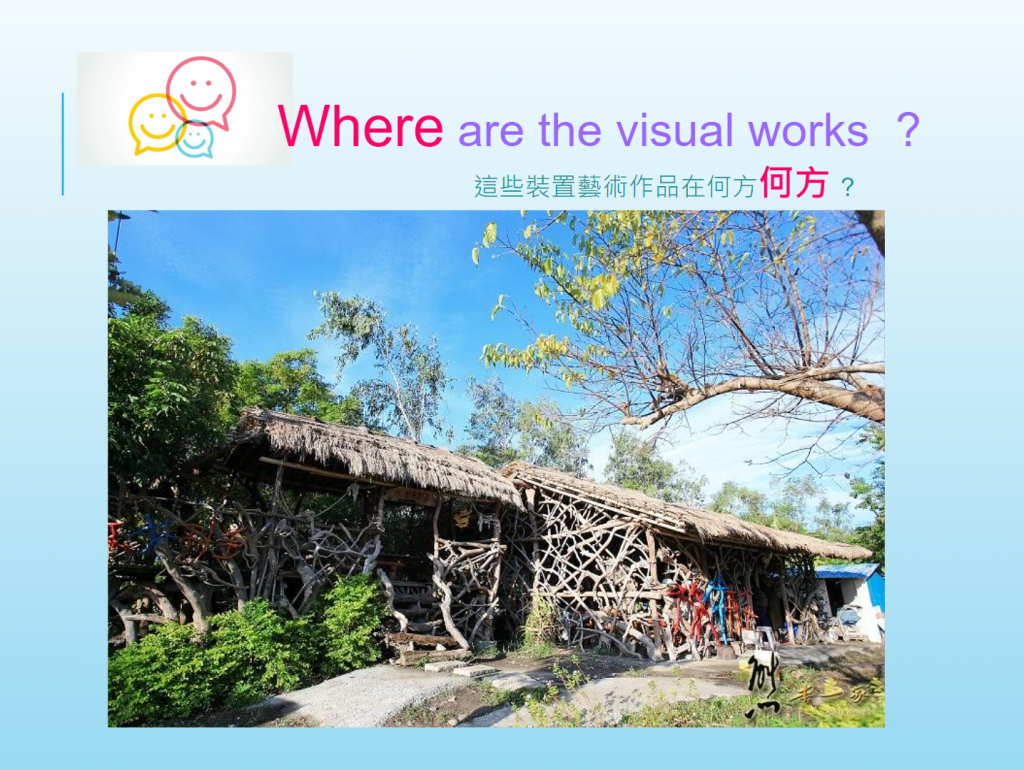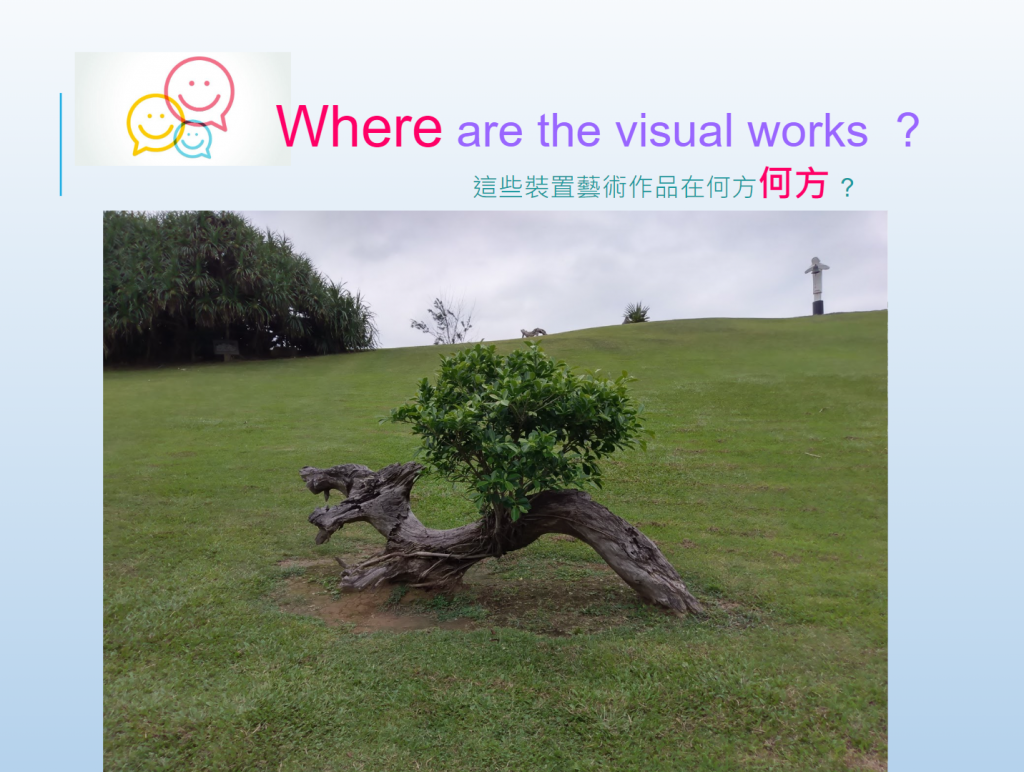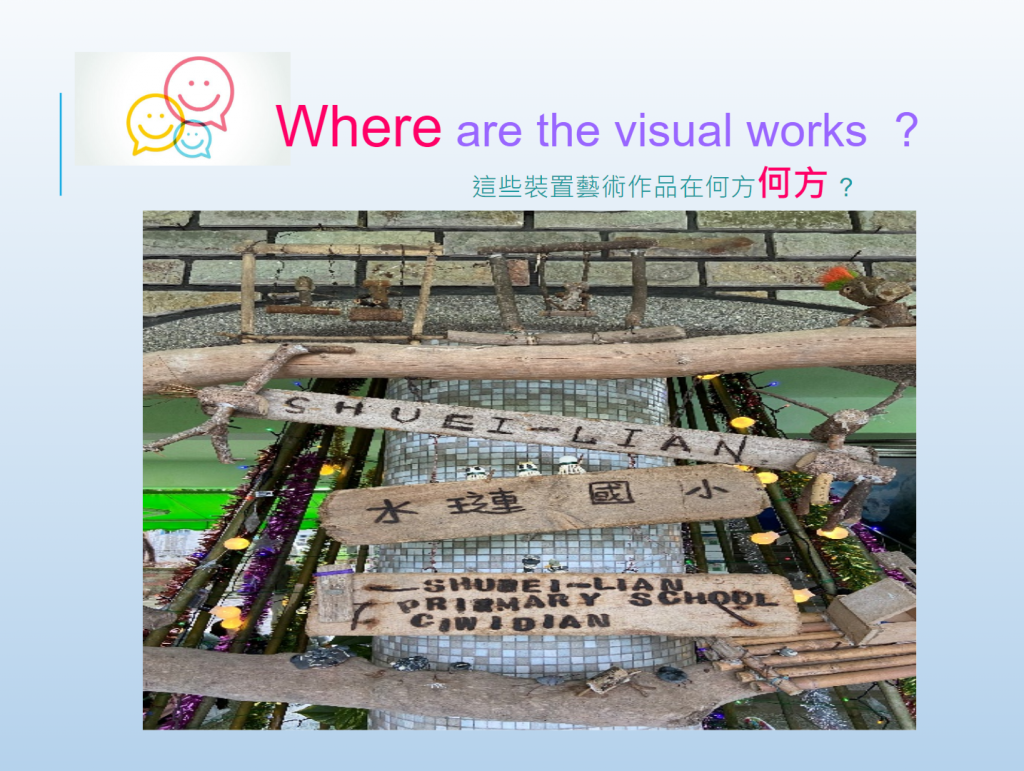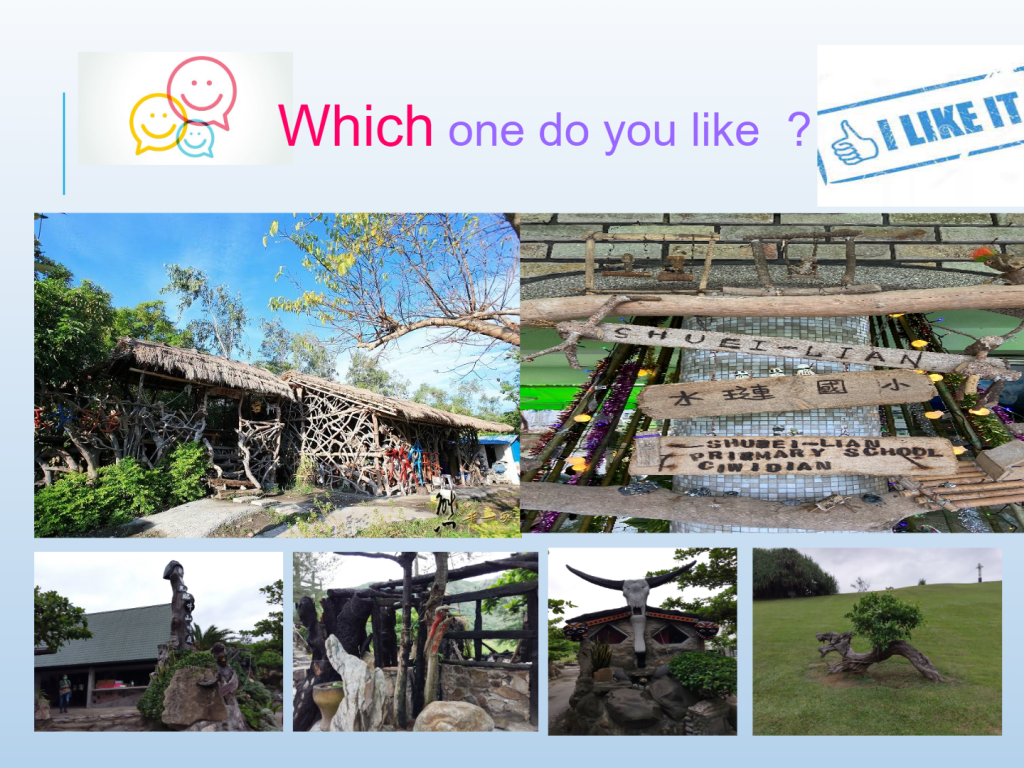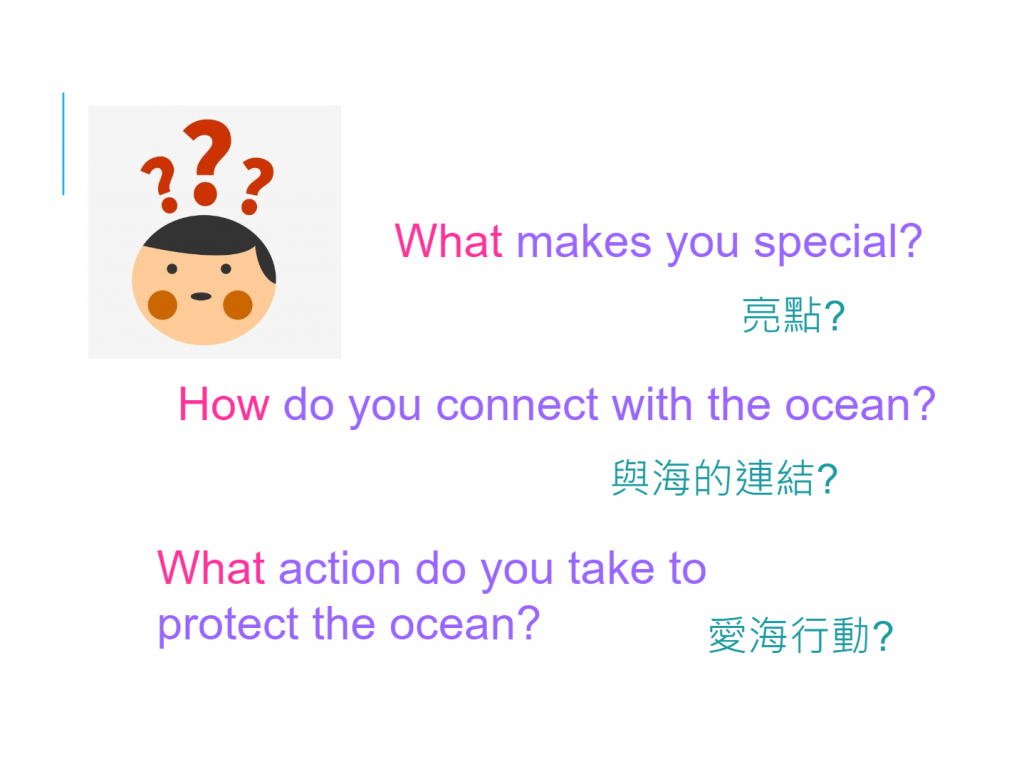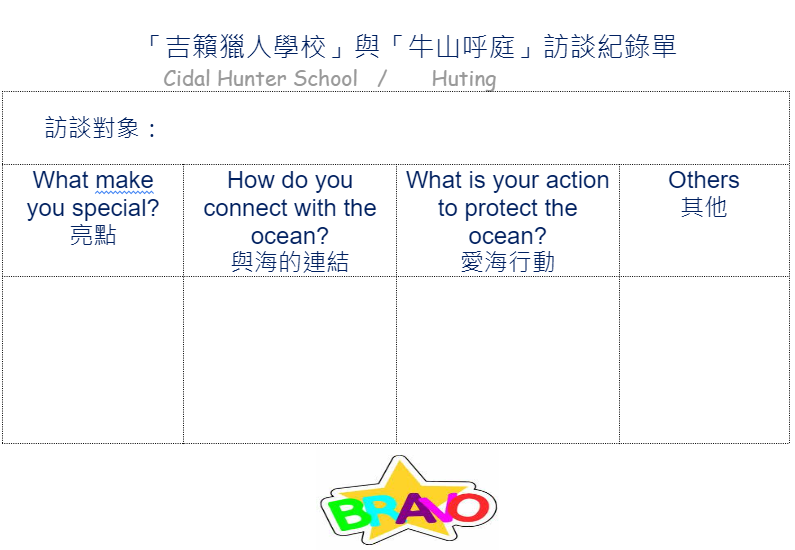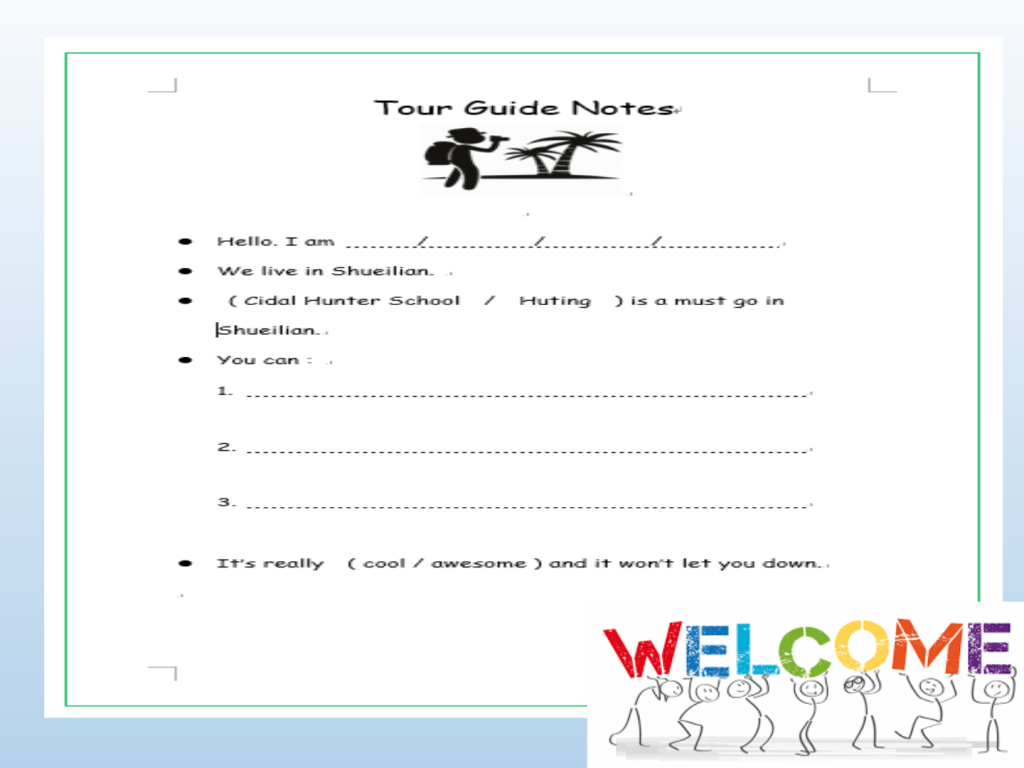對應國際教育議題實質內涵
彰顯國家價值
善盡全球公民責任
單元名稱 3
融入領域
語文、綜合活動
上課節數:2節
年級:年級
國際教育議題實質內涵
學生學習目標
總結性評量
Ciwidian在海邊 (2節)
| 教學節次 | 第1節 ~ 第3節 | ||
| 相關領域學習表現 (第二學習階段以上應包含英語文領域領綱) |
[綜合領域] 3d-II-1 覺察生活中環境的問題,探討並執行對環境友善的行動。 3d-III-1 實踐環境友善行動,珍惜生態資源與環境。 [英語文領域] 1-Ⅱ-9 能聽懂簡易的日常生活用語。 5-Ⅲ-4 能聽懂日常生活應對中常用語句,並能作適當的回應。 7-Ⅲ-3 在生活中能把握機會,勇於嘗試使用英語。 |
||
| 校訂國際教育 雙語學習內容 |
領域學習內容 Content | ||
|
|||
| 語言學習內容 Language of Learning | |||
4W :what、where、why、how agree、disagree country/place、problem、solution
What did Vaki / people do by the sea? They (activities). Do you agree / disagree about “Our Fridge is the Pacific Ocean.”? Agree/ Disagree. |
|||
| 單元學習目標 (50~100字內) |
以4W思考阿美族文化與海的依存關係並透過閱讀報導與耆老訪談,歸納與比較水璉海岸之今昔變化與親海活動之異同,並學習以關鍵字查詢其他國家的海洋汙染案例。 | ||
| 教學步驟 | 引導做法 | 教學資源 | 認知能力 |
| 1-1 阿美族的冰箱 (1節) 1、準備活動:
What do you do by the sea? ※ S may say:go fishing, collect seafood, go swimming ※ T repeats what S say & show the words on the slide :go fishing, collect seafood, go swimming 2、發展活動:文章1-1 (1) 閱讀前的提問: T Q Who is he? 照片中的人誰? (S:獵人學校阿旺教練) (T:Coach 阿旺 from Cidal Hunter School) T Q Where is he? 照片拍攝地點在哪兒? (S:at the beach / by the sea在海邊) (T:He is by the sea and he is at the beach.) TQ What’s he doing? 他在做什麼? (S:collect seafood在抓浪花蟹) (T:He is collecting crabs. And the crabs are not like usual crabs you see on the market. They are Hippaovalis.) TQ. How can he do it? 浪花蟹怎麼抓? (S: 依個人經驗回答) (T:We’ll read an article to see how. ) (2) 閱讀文章1-1 1. Reading 1-1 ※ T shows S the report (Article 1-1) but uses Slides 1-4~1-6 to make the reading easily. ※ Before reading, T can explain the steps by realia and body languages for a better understanding 2. 小組討論與發表 TQ. How to catch the Hippaovalis? 浪花蟹怎麼抓? S have a group discussion (T shows slide1-8 as aid) ※ T summerize: 1. Get a cold, dead squid 2. Get some metal spears 3. Skewer the squid on the spears 4. Drive the stake into the sand (where the ocean meets the shore) 5. Wait for 15 minutes 6. Scoop up the wet sand to get Hippaovalis 以微腐的花枝或烏賊綁在鐵棒上,插入海陸交界的砂子中,等待10-15分鐘後,以鐵網篩出浪花蟹) ※ 四人一組討論與倆倆一起發表,發表前說明評分表單,說明評量表單後帶學生練習摘要一次,再作小組練習與發表。 (3) 延伸討論:村子裡的人還會到海邊做哪些活動? ※ T uses target sentences & asks S: What do people in Shueilian do by the sea? ※ S may say:go fishing, collect seafood, go swimming … ※ T repeats what S say & show more pictures on the slide :go fishing, collect seafood, go swimming collect plants (4) 看看其他地方的阿美族人還會到海邊做哪些活動? ※ 影片:沙灘小精靈—濱刺麥3”08 ※ T uses target sentences & asks S: What do other Amis do by the sea? ※ T repeats what S say & show more words on the slide :go fishing, collect seafood, go swimming, play with sand, laze away collect plants, hold rites ※ T introduces Littoral Spinegrass and play a film to explain how do the Amis people in Taitung play with Littoral Spinegrass 3、 綜合活動: (1)思考:對於「大海是阿美族人的冰箱」這句話的看法與認同度。 ※ 留待第三節課討論 (2) 預告下節活動:耆老訪談 ※ T quotes the Amis saying, “Our Fridge is the Pacific Ocean. “and asks S to think about it and announces that there will be a further discussion about it in the third class. ※ T announces the interview in next class 1-2聽Vaki說故事(1節) 1、準備活動: 提醒:專心聆聽、筆記紀錄耆老訪談內容、踴躍提問 (作為本節課評量規準) ※ T reminds S to concentrate, take notes and ask good questions in the interview of the elders (Vaki) 2、發展活動: (1) 介紹耆老:文章1-1教練 (2) 聽Vaki分享以前的海邊活動 (3) 筆記與發表:Vaki提到的活動 ※ T uses target sentences & asks S: What did Vaki do by the sea? ※ S may say: go fishing, collect seafood, go swimming, collect plants… ※ T repeats what S say & show the words on the slide: went fishing, went swimming, collected seafood, collected plants, played /lazed away, held rites 3、綜合活動: (1) 提問與回答: TQ. What is your favorite activity? 最喜歡Vaki分享的哪一項活動? S share their favorite activity. TQ. Could you do this by the sea? Why? How do you feel about it? 這些活動現在還能做嗎? 為什麼?對於 這樣的改變有什麼感覺? S may conclude to the disappearing of the beach or the ocean pollution (too much garbage at the beach). ※ 歸納至海灘消失 & 海洋汙染 (2) 預告下次活動: 1. 思考:對於「海是阿美族人的冰箱」這句話的看法與認同度。 2. 資料搜尋:其他地方的海灘是否也有污染與破壞問題。 ※ T quotes the Amis saying, “Our Fridge is the Pacific Ocean.”and asks S to think about this and announces that there will be a further discussion in next class. ※ T announces a research work for next class:more pollutions in other coasts 1-3消失的海岸線 (1節) 1、準備活動:
※ T reviews:What do other Amis do by the sea? ※ S answers:go fishing, collect seafood, go swimming, play with sand, laze away collect plants, hold rites 2、發展活動: (1) 討論:是否同意「太平洋是阿美族的冰箱」? 1. 小組討論 2. 意見表達 3. Film:《海起來吧》--大海就是冰箱?阿美族人和海是這樣相處的! https://www.youtube.com/watch?v=xcanwdpHvVs (4”02) ※ T uses the target words:agree / disagree to ask about the agreement of the saying “Our Fridge is the Pacific Ocean.” and asks S to discuss it in groups. ※ S use agree / disagree cards to show the results of group discussion and deliver their opinions. ※ T plays the Film 《海起來吧》 and survey again after the film. (2) 比較水璉現在與過去在海邊的活動 / 回顧前張PPT海祭的照片 ※ T shows the slide :the changes of the coast of Shueilian/Ciwidian. (3) 提問與回答: TQ. What’s wrong? 哪裡不一樣了? (S: the building is gone、the beach becomes smaller、more and more garbage、no boats海岸消失、垃圾變多、沒有漁船出海了……) TQ. Why? How does it change Ciwidian?為什麼水璉不一樣了?對水璉村的生活有影響嗎? (S: more and more garbage、no fishing boats垃圾變多、漁船無法出海……) TQ. Only in Ciwidian? Where else may have similar problems? How do they do? 你覺得其他以海為生的地方也有同樣 的問題嗎?他們怎麼面對或解決這樣的困境? (S may deliver their own opinions) (4)資料搜尋: 分組作資料搜尋並將搜尋結果依「國家/地點」、「狀況」、「解決方式」,書寫於不同顏色色紙上,書寫完貼於白板上 ※ T put 3 word-cards (country/place, problem, solution) on board and gives S 10 minutes to surf on the Internet for answers ※ Before surfing, T leads S to work out the key words. ※ S write answers on color papers. 3、綜合活動: (1) 歸納搜尋結果 (2) 預告:以水璉為起點,再看看台灣西部的一個案例,並以今日搜尋結果深入瞭解世界其他國家怎麼面對困境與尋找解決之道 ※ T collects and reviews the answers from each group. ※ T previews the next unit:more examples in the west coast of Taiwan and in the countries from some groups |
Bilingual Slides Slide 1-2 Activities by the sea 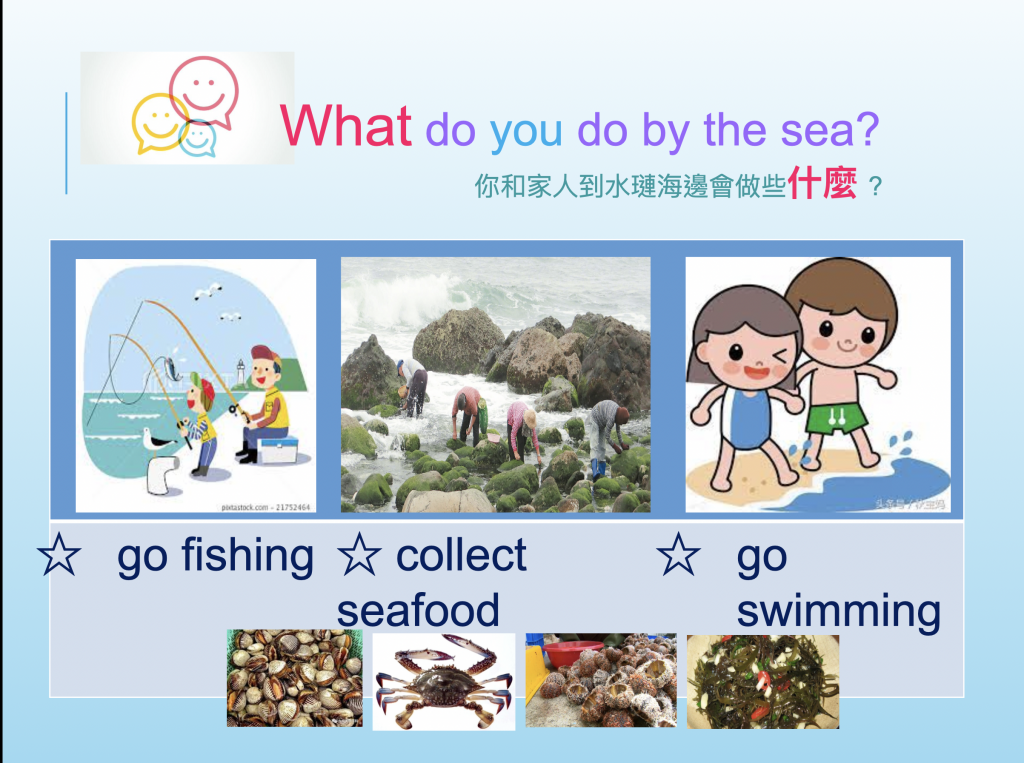 Slide 1-3 吉籟獵人學校教練於海邊抓浪花蟹照片 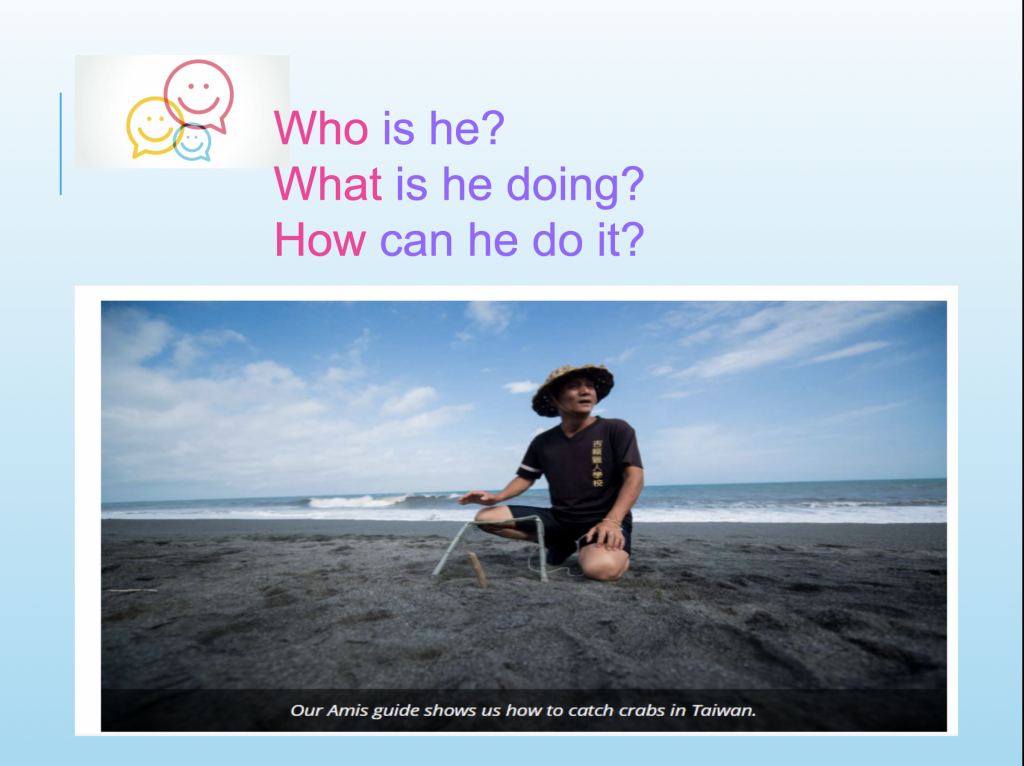 Slide 1-4~1-8 Article 1-1 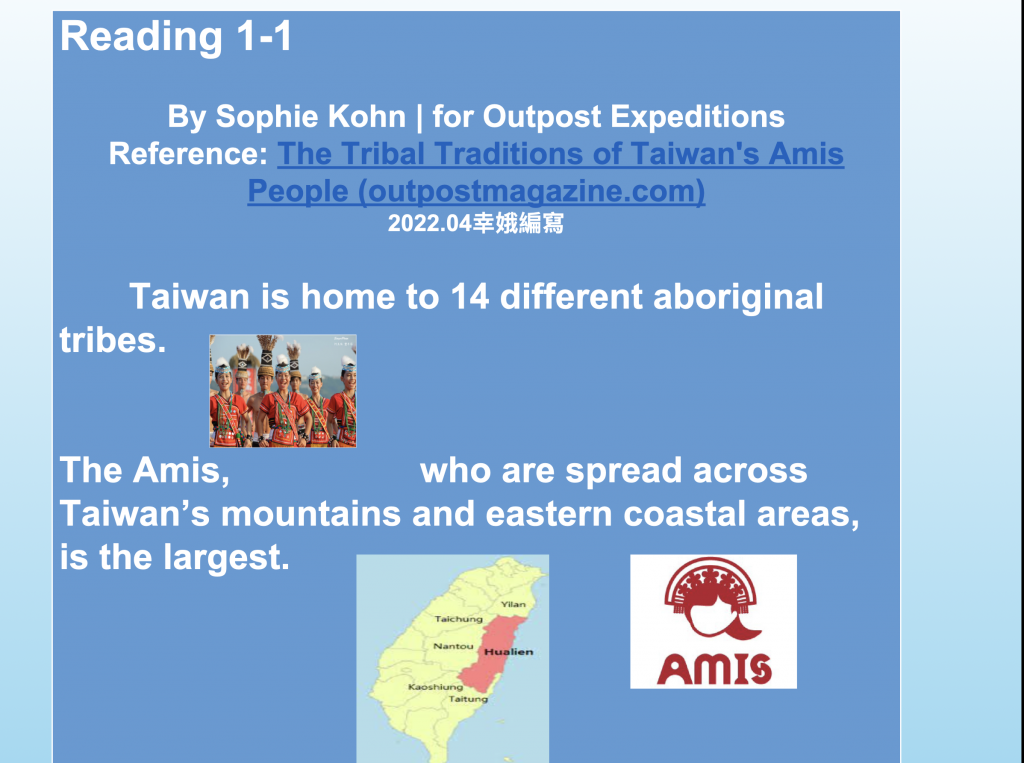 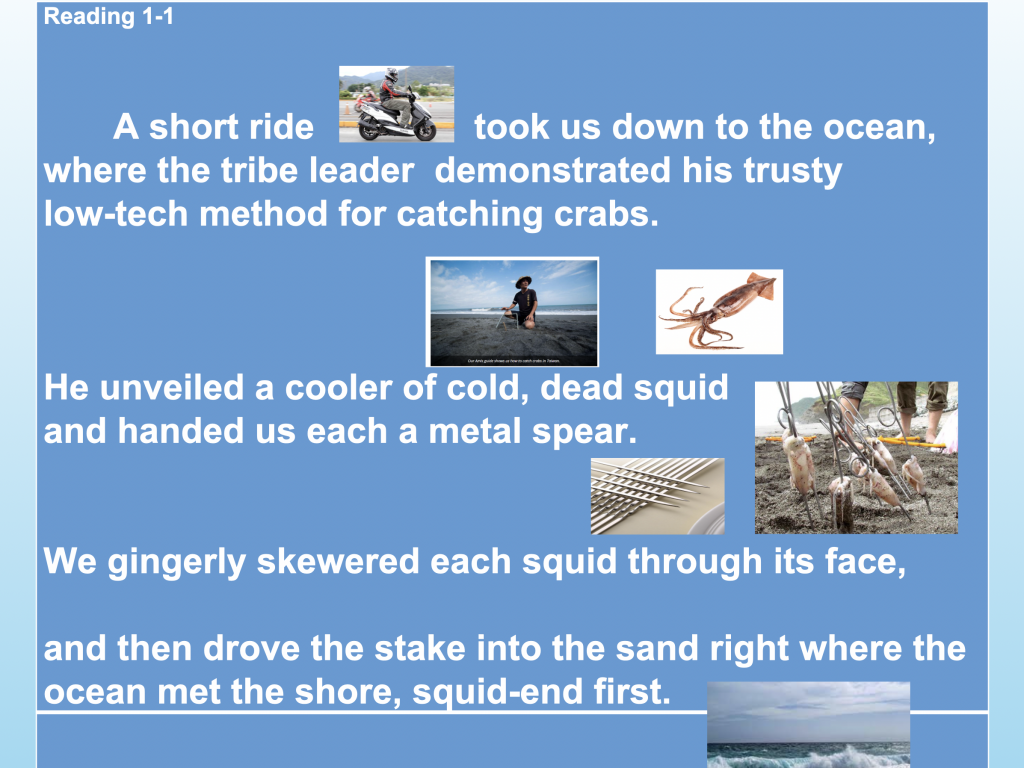 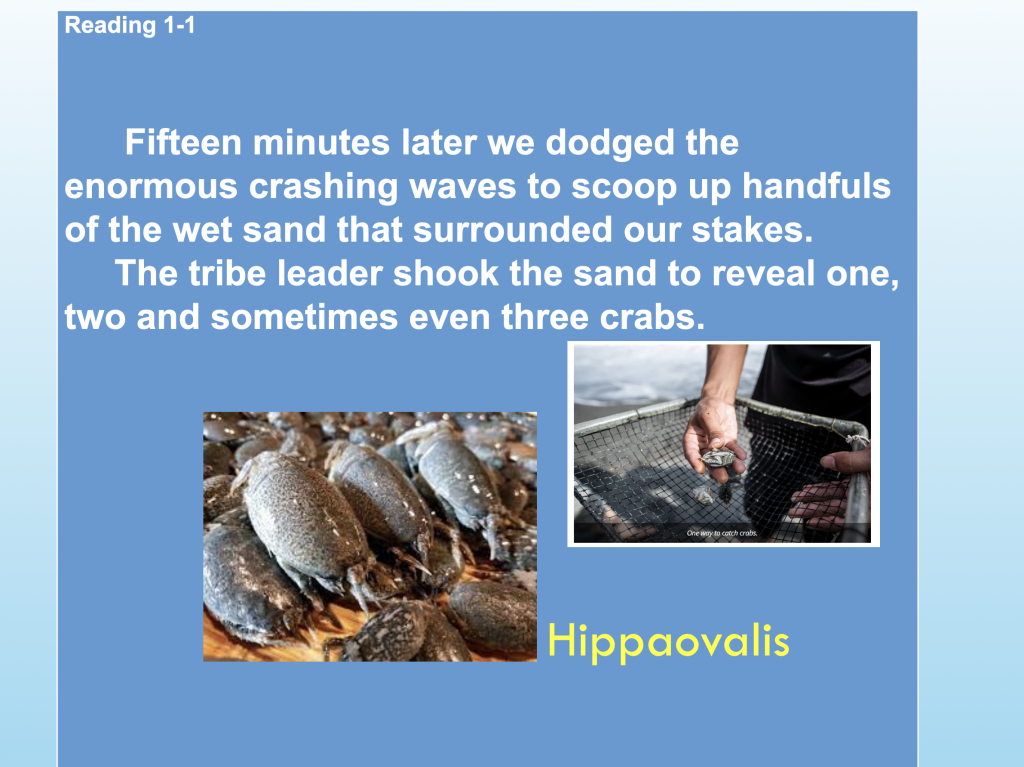 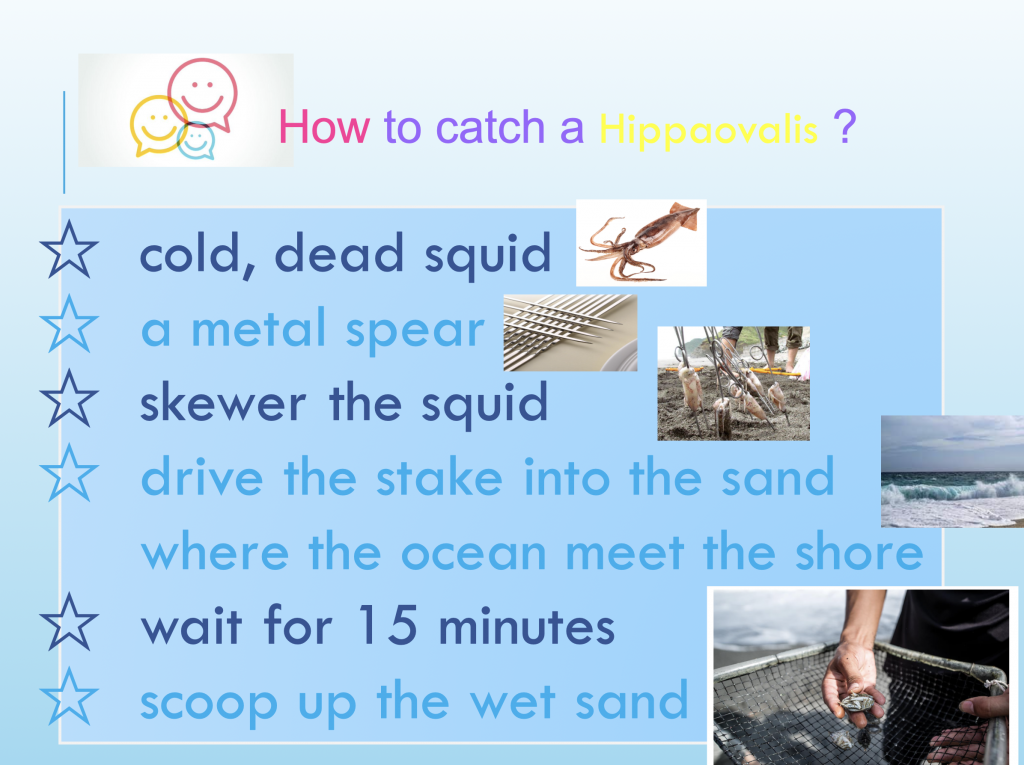 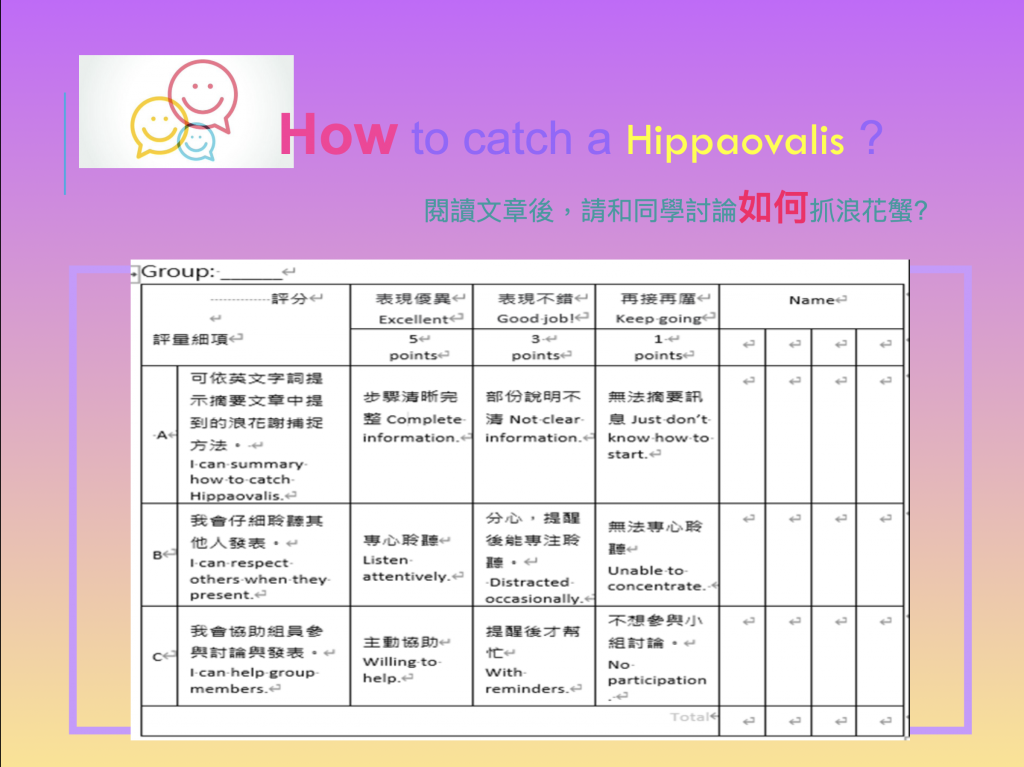 Slide 1-9 Activities by the sea 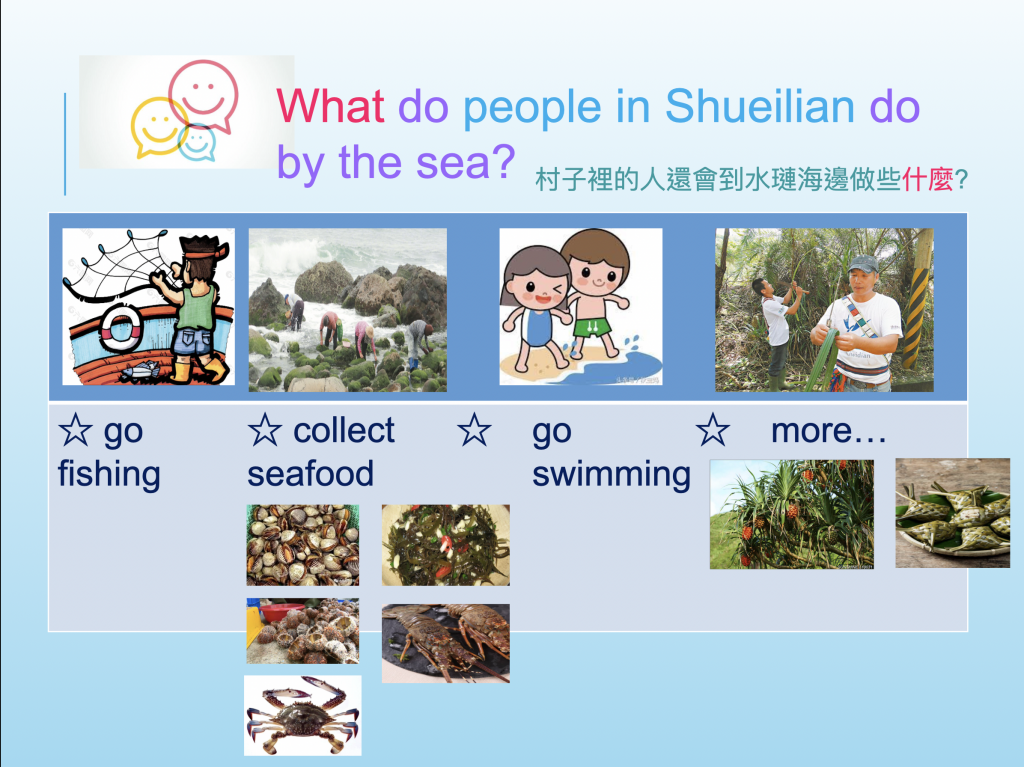 Slide 1-10 Activities by the sea 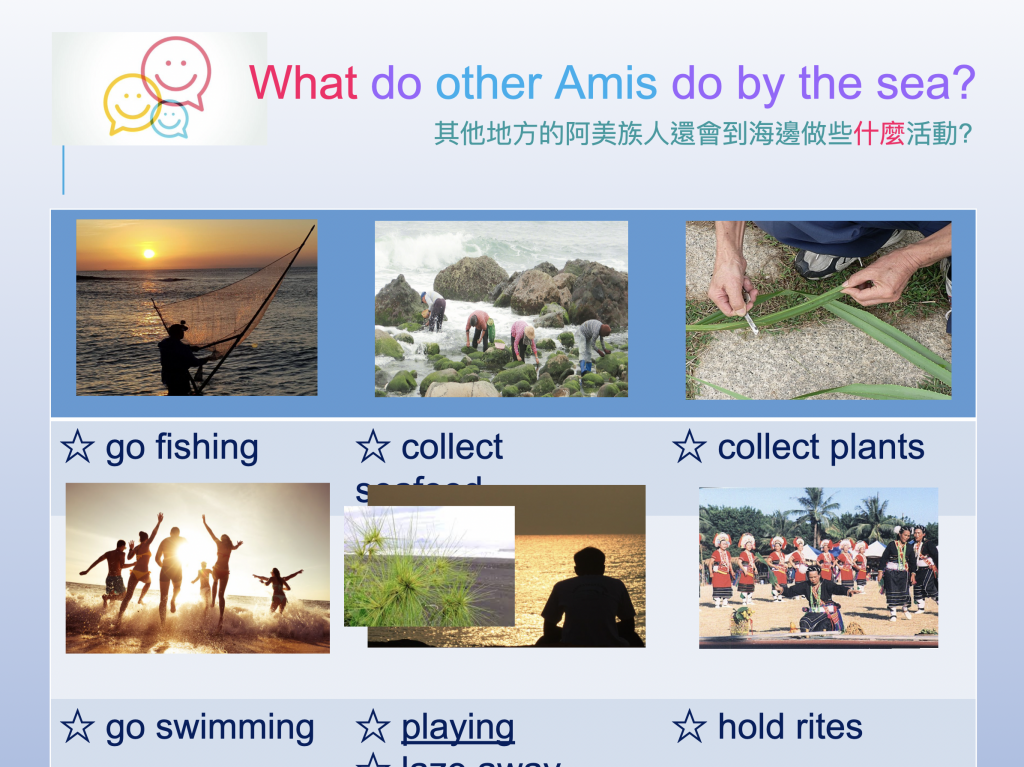 影片:海邊植物濱刺麥 Bilingual Slides Slide 1-12 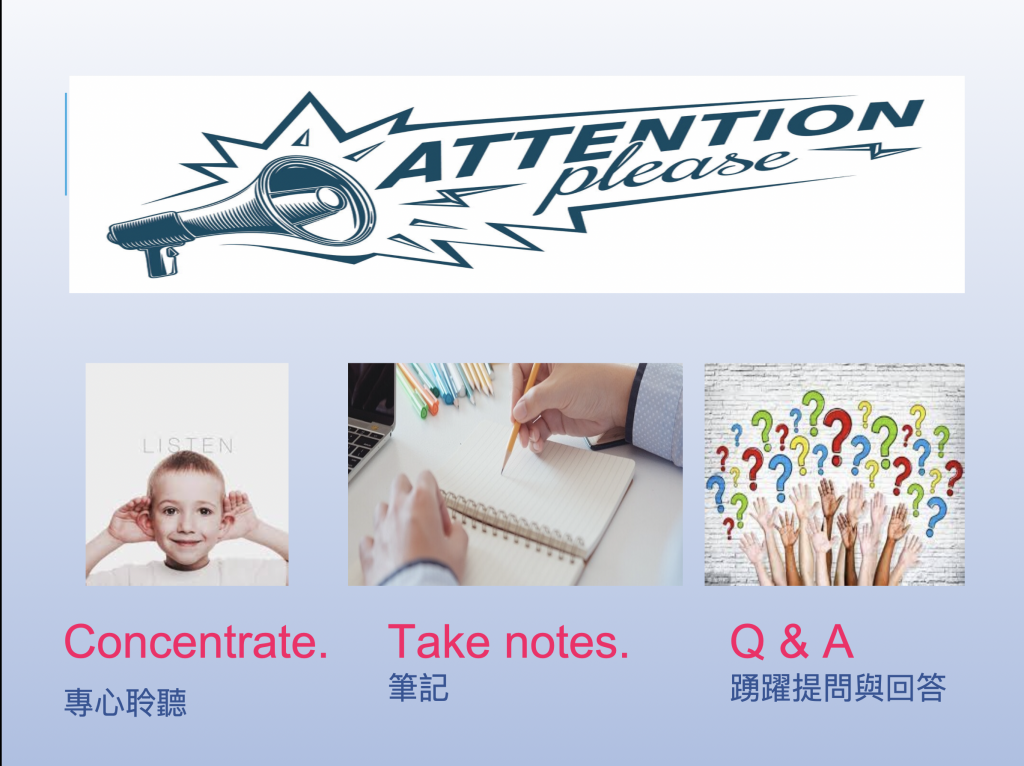 Slide 1-13 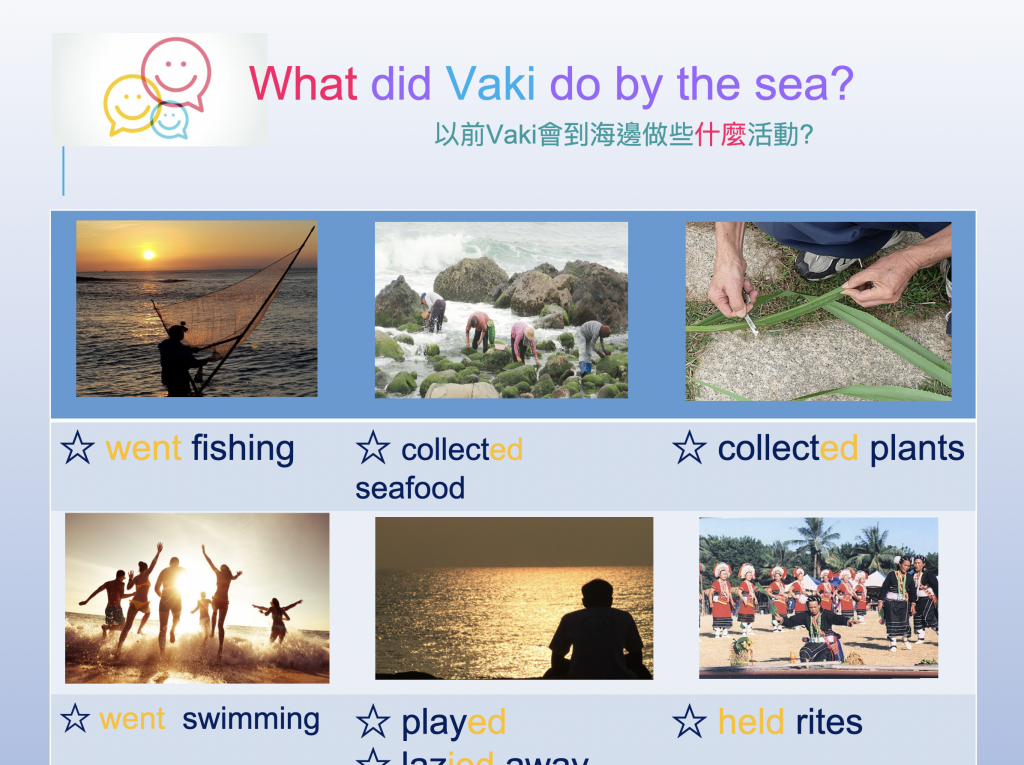 Slide 1-14 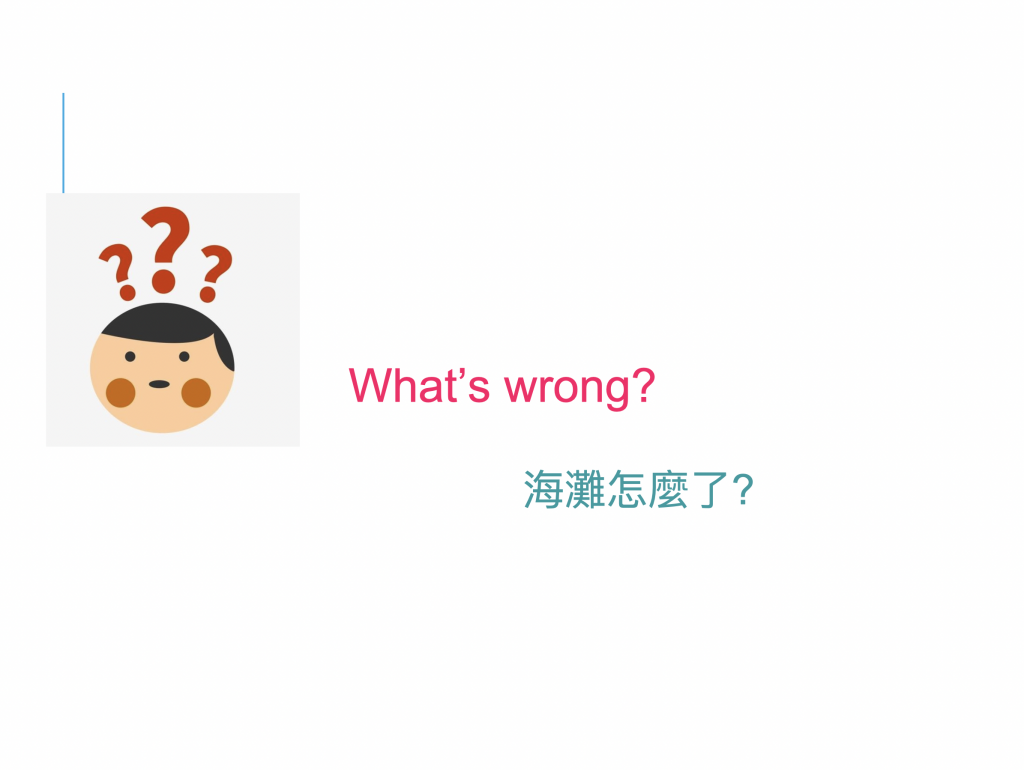 Slide 1-15 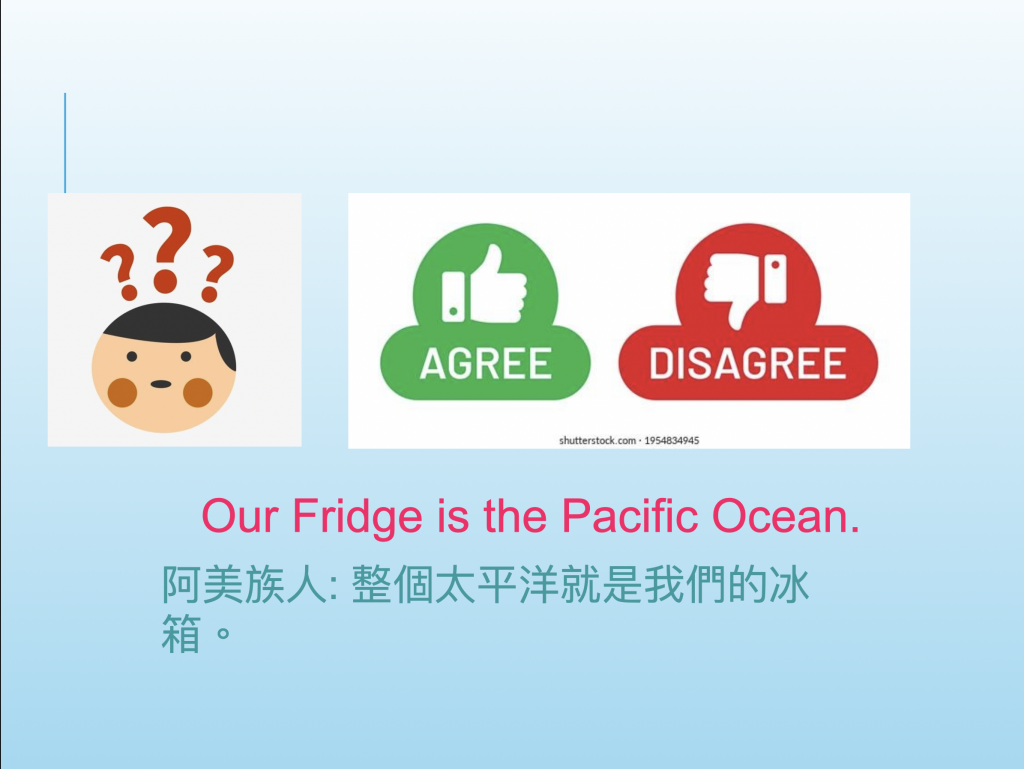 Bilingual Slides Slide 1-17 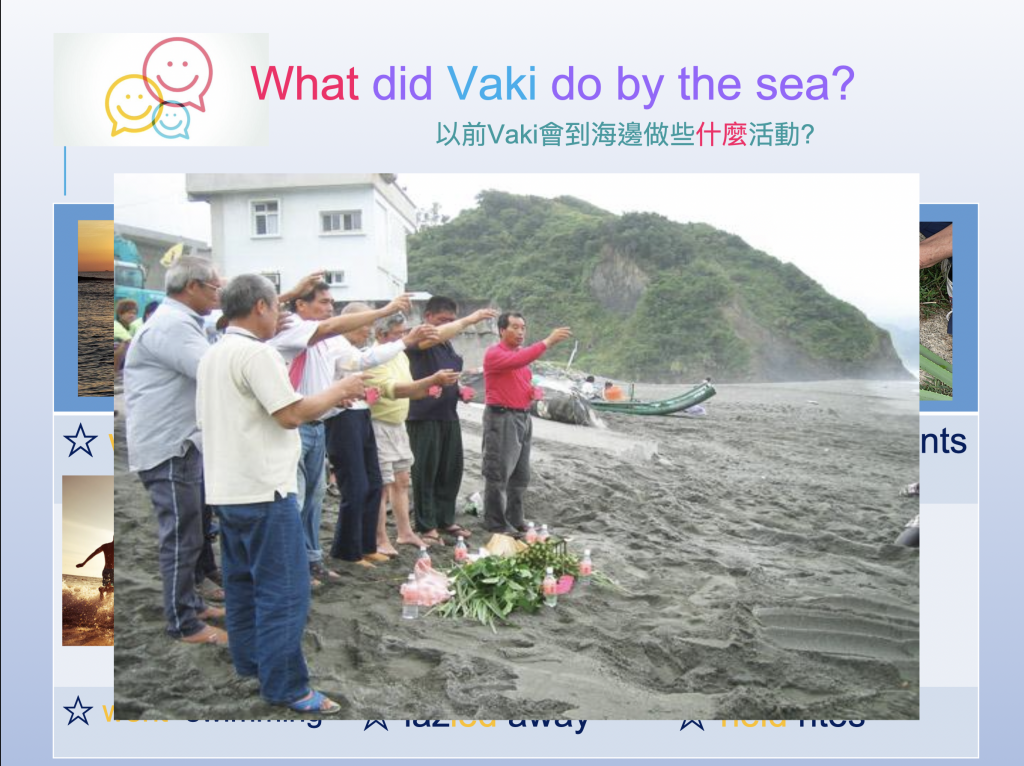 Slide 1-18 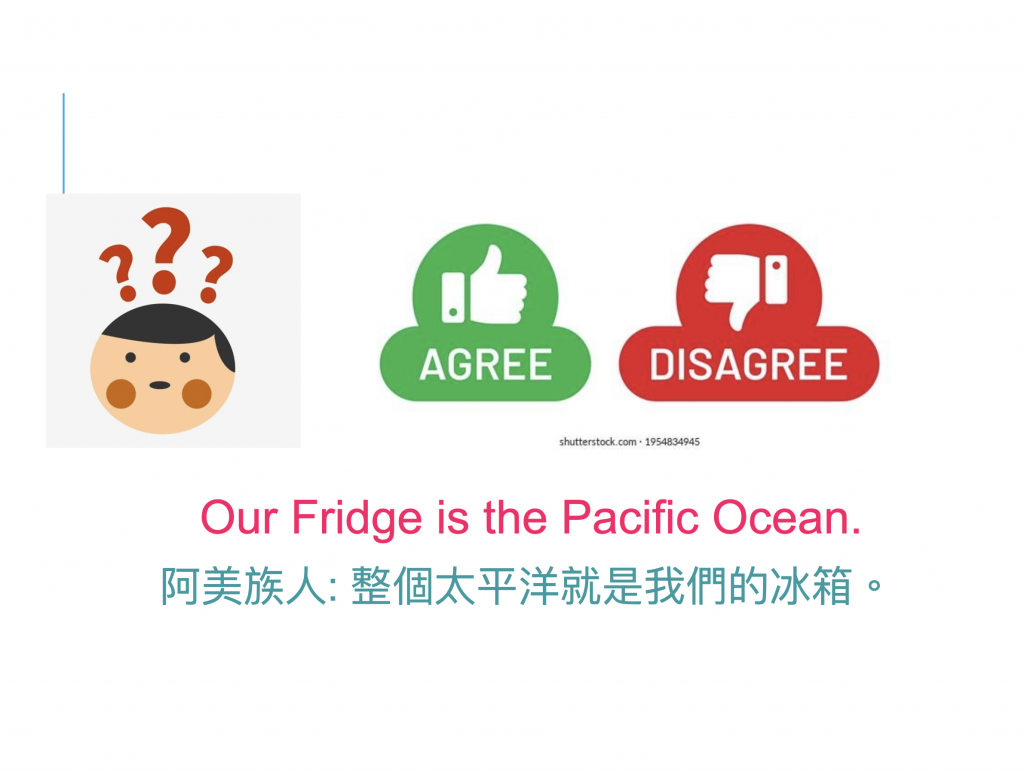 Slide 1-19 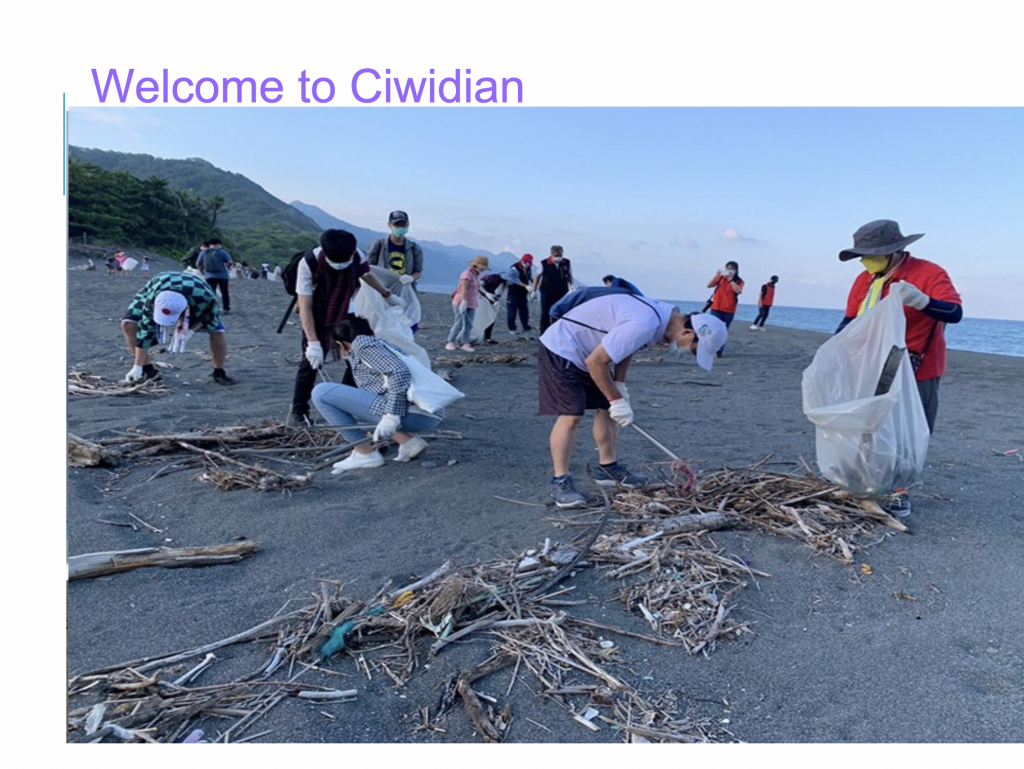 Slide 1-20~1-21 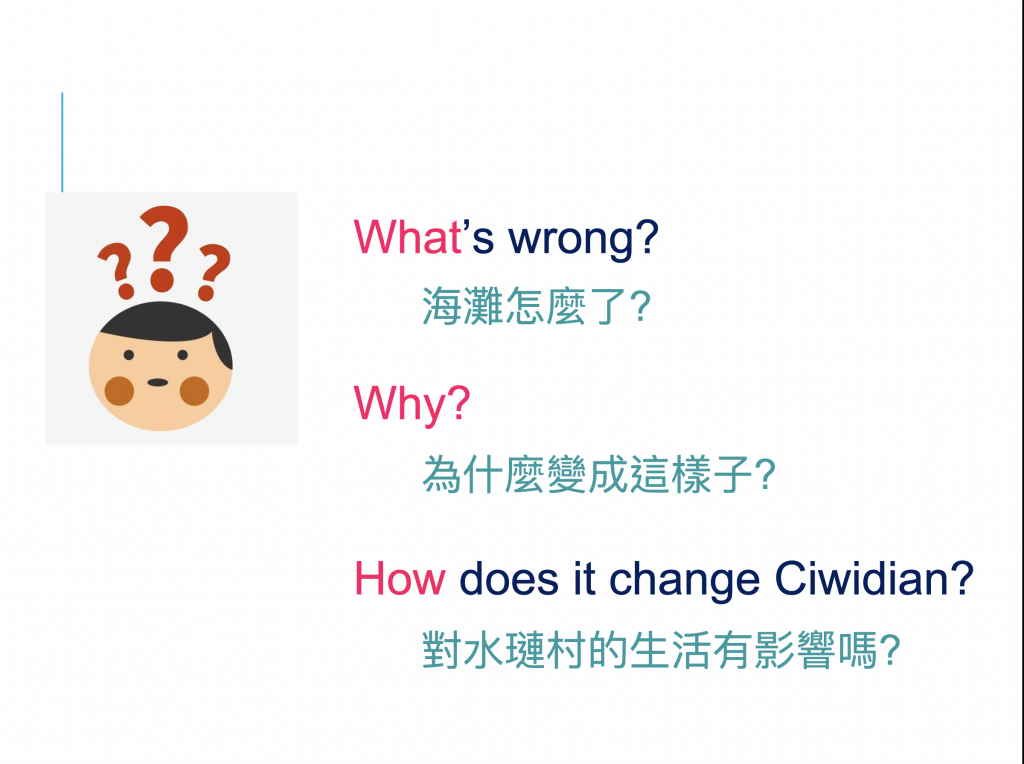 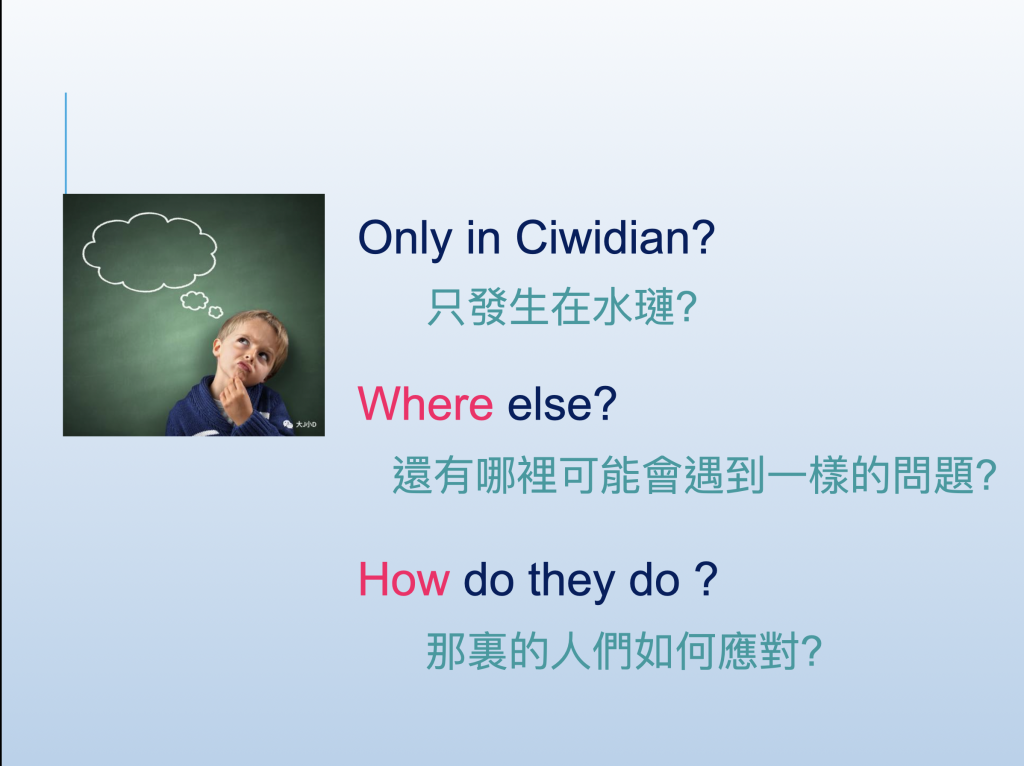 Slide 1-22  Word cards:country/place problem solution A5 color papers markers laptops / tablets |
學生能陳述相關生活經驗 學生能依圖片訊息與其相關生活經驗回答提問 學生能摘要文章中抓浪花蟹的方法 Rubric 1-1 學生能陳述其相關生活經驗 學生能歸納阿美族海邊的活動 Rubric 1-2 學生能針對訪談內容適時提問 學生能 筆記與摘要耆老所提的活動 學生能 推論今昔活動相異的原因 列舉阿美族人的海邊活動 學生能表達對於「太平洋是阿美族的冰箱」的看法,歸納並陳述小組意見 學生能比較語說說明海岸地變化與推問可能原因 學生能應用資訊檢索能力查詢其他海洋汙染案例 |
|
融入領域
語文、綜合活動、藝術
上課節數:4節
年級:年級
國際教育議題實質內涵
學生學習目標
總結性評量
困境與轉機—他山之石(4節)
| 教學節次 | 第4節 ~ 第7節 | ||
| 相關領域學習表現 (第二學習階段以上應包含英語文領域領綱) |
[綜合領域] 3d-II-1 覺察生活中環境的問題,探討並執行對環境友善的行動。 3d-III-1 實踐環境友善行動,珍惜生態資源與環境。 [藝術領域] 3-Ⅲ-5 能透過藝術創作或展演覺察議題,表現人文關懷。 [英語文領域] ◎ 1-Ⅱ-9 能聽懂簡易的日常生活用語。 ◎ 5-Ⅲ-4 能聽懂日常生活應對中常用語句,並能作適當的回應。 7-Ⅲ-3 在生活中能把握機會,勇於嘗試使用英語 |
||
| 校訂國際教育 雙語學習內容 |
領域學習內容 Content | ||
| 1. 大潭藻礁議題與模擬公投。 2. 夏威夷垃圾島之海洋汙染狀況與解困之法。 |
|||
| 語言學習內容 Language of Learning | |||
| 目標字詞target words: 6W :what, where, why, when, who, how Algal Reef, garbage patch, garbage wave, garbage village agree、disagree 目標句型target sentences: Do you agree / disagree? I agree / disagree. |
|||
| 單元學習目標 (50~100字內) |
以6W問句結合時事了解台灣公投案四大潭藻礁事件中經濟發展與海洋保護的兩難議題,並由太平洋彼岸的夏威夷垃圾島初探全球海洋汙染狀況與解困之法。 | ||
| 教學步驟 | 引導做法 | 教學資源 | 認知能力 |
| 大潭藻礁保衛戰 (2節) 一、準備活動: 引起動機:
(S: 選舉公報;T answers:it’s an election announcement) TQ. What is referendum (referenda)? 什麼是公投? (S answers;T concludes: people votes about public issues ) TQ. Who can vote? 誰有資格投票? (S answers;T gives answers:18) TQ. What’s the main issue of referenda 2021? 2021年的公投議題為何? (S answers;T shows the slide:Nuclear plant, Ban on ractopamine-containing pork imports, Referendum dates, Algal reef protection) T announces that these 2 classes will focus on the issue of Algal reef protection. 二、發展活動: (一) 大潭藻礁公投案: 1. 讀懂公投案文 練習斷句 找出關鍵字 ※ T prepares S the copy of the algal reef protection as a reading material. S work in groups to decode the phrases. 2. 認識大潭藻礁 地理位置:map 什麼是藻礁? 為什麼藻礁珍貴? Film (5’45~13’11) ※ Film:藻礁,你不知道的海岸紅寶石 Algal reef, the hidden heritage of Taiwan | 林惠真 Hui-Chen Lin | TEDxDadun https://www.youtube.com/watch?v=UaVIPj6Vy3c 兩難議題:經濟發展vs. 自然保育 ※ T shows the location of Da-tan Algal Reef ※ T plays the film to introduce Da-tan Algal Reef ※ T concludes the conflicts of economic development and environmental protection (二) 我的海岸我做主
閱讀正反面文宣 ※ 藻礁公投 https://algalreef2021.teia.tw/#m2 以行動劇方式陳述立場(可書寫文宣海報、組織口號) ※ T divides S in 2 groups and prepares S reading materials for con and pro ※ S reads, discuss and concludes the opinions by acting or oral presenting. ※ T uses the target sentences: Do you agree / disagree? ※ S share their opinions with the word:agree / disagree
比較公投結果 心得分享 ※ 票單依正反方分兩色套印,可比較選擇 結果是否受到陳述影響 ※ T let S show their personal opinions by means of practicing the process of referendum (but S needs to write down one reason):vote (mark the ballot paper and place the ballot paper in the ballot box), count the ballot slips, announce the results ※ S shares how they think about the result 三、綜合活動: (1) 複習:6W (2) 課程預告:國外案例 ※ T reviews 6W ※ T previews the next unit:more examples abroad from the group surfing results in last class. |
Bilingual Slides Slide 2-2 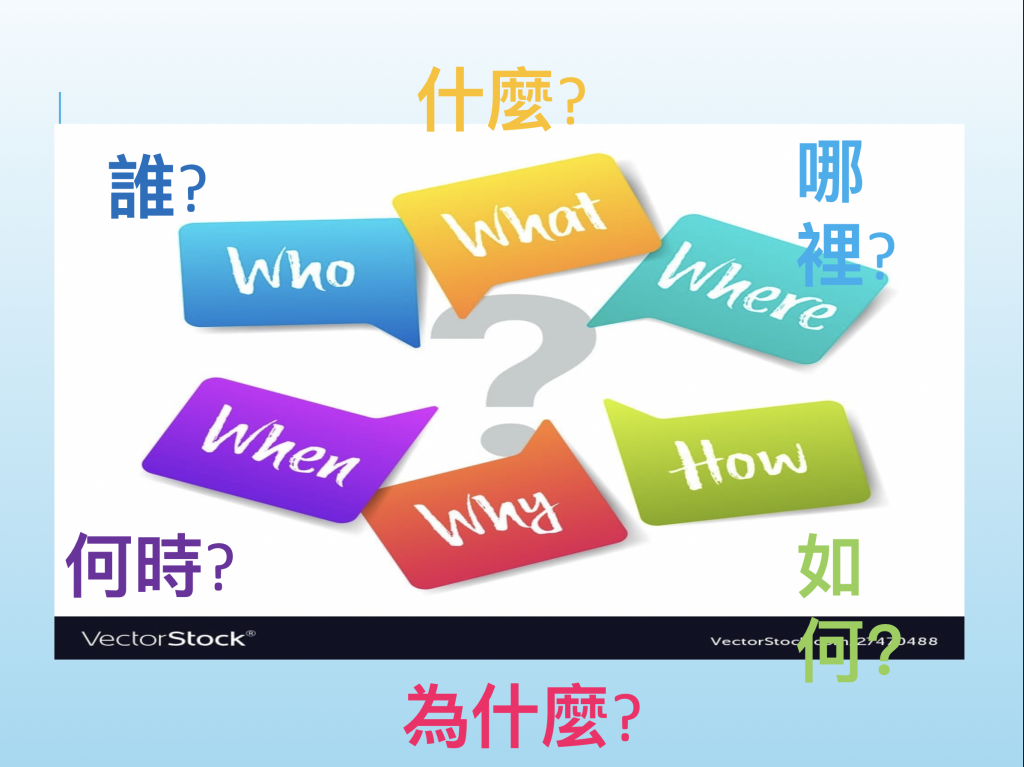 Slide 2-3~2-5 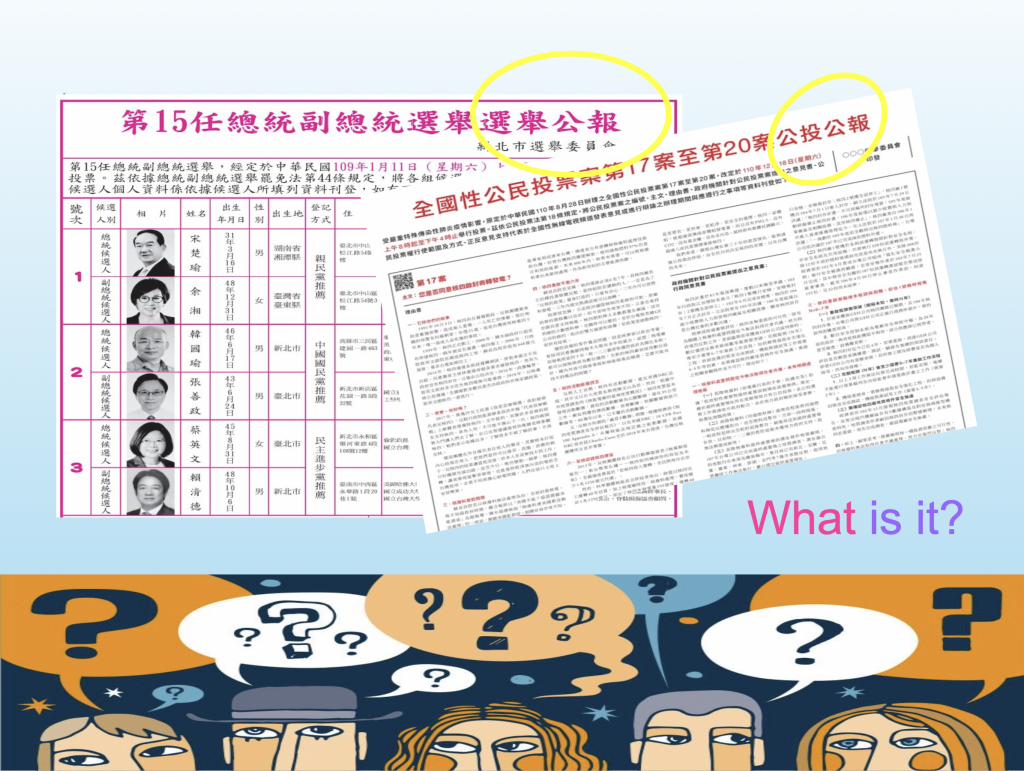 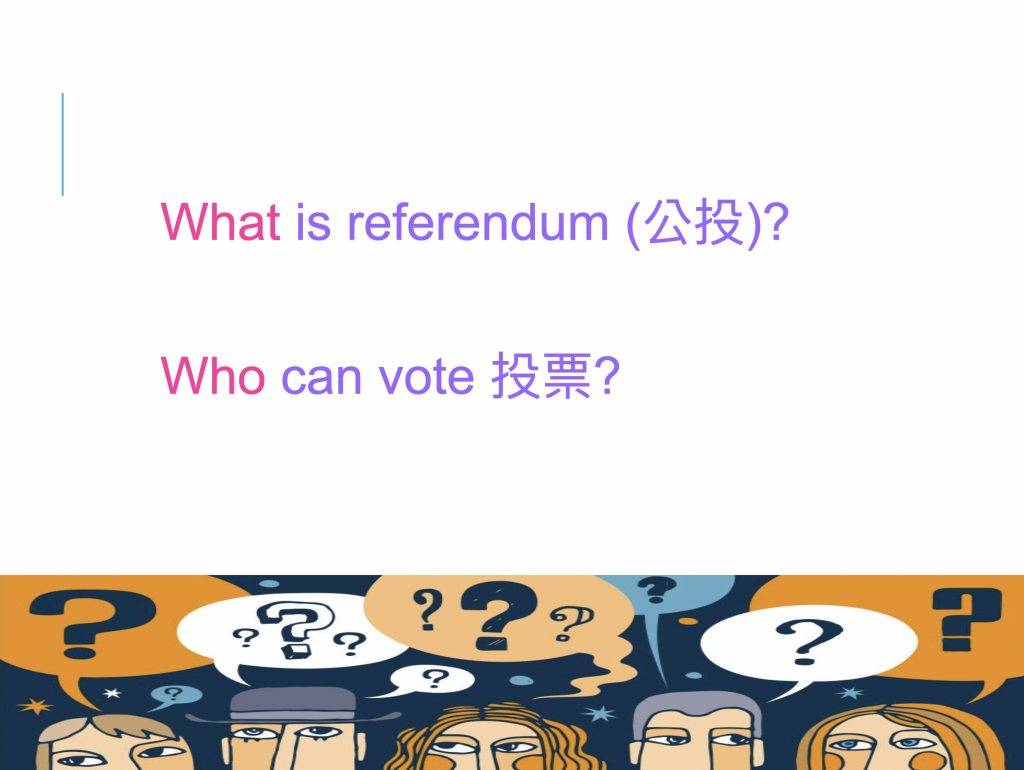 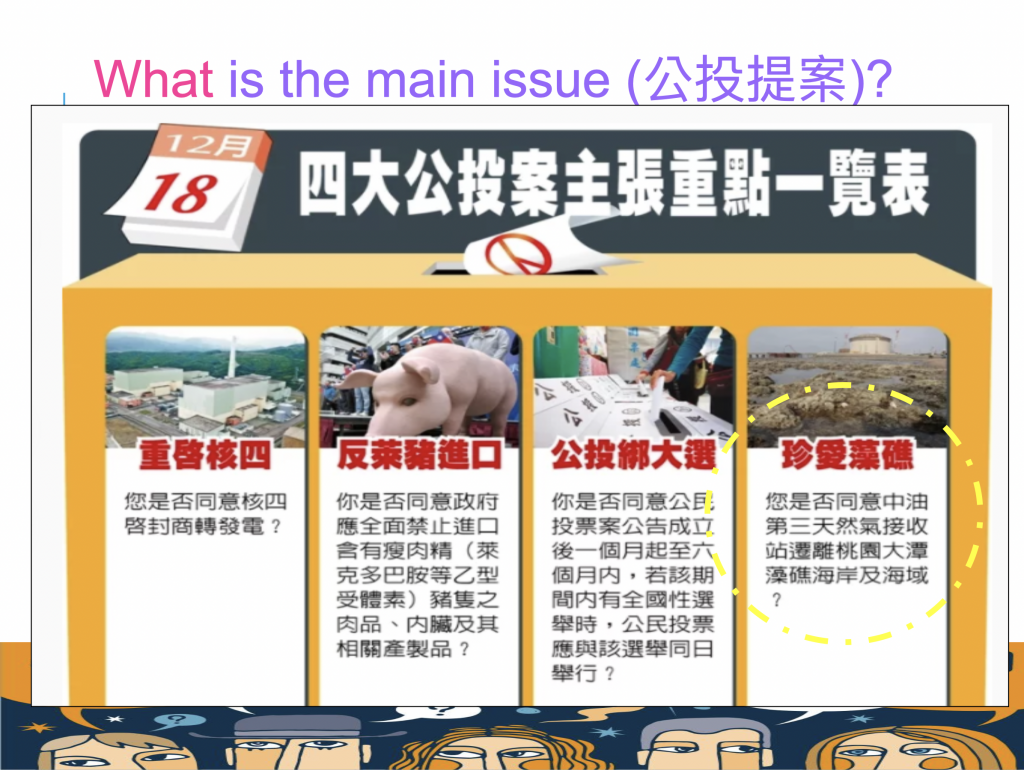 Slide 2-6 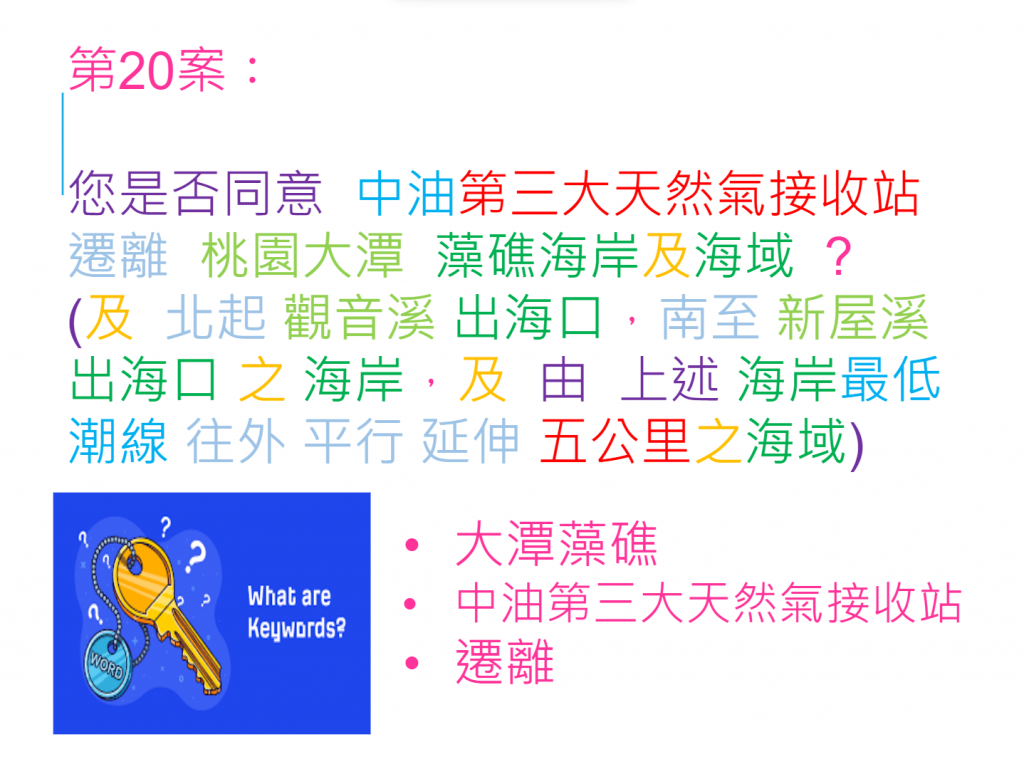 Slide 2-7 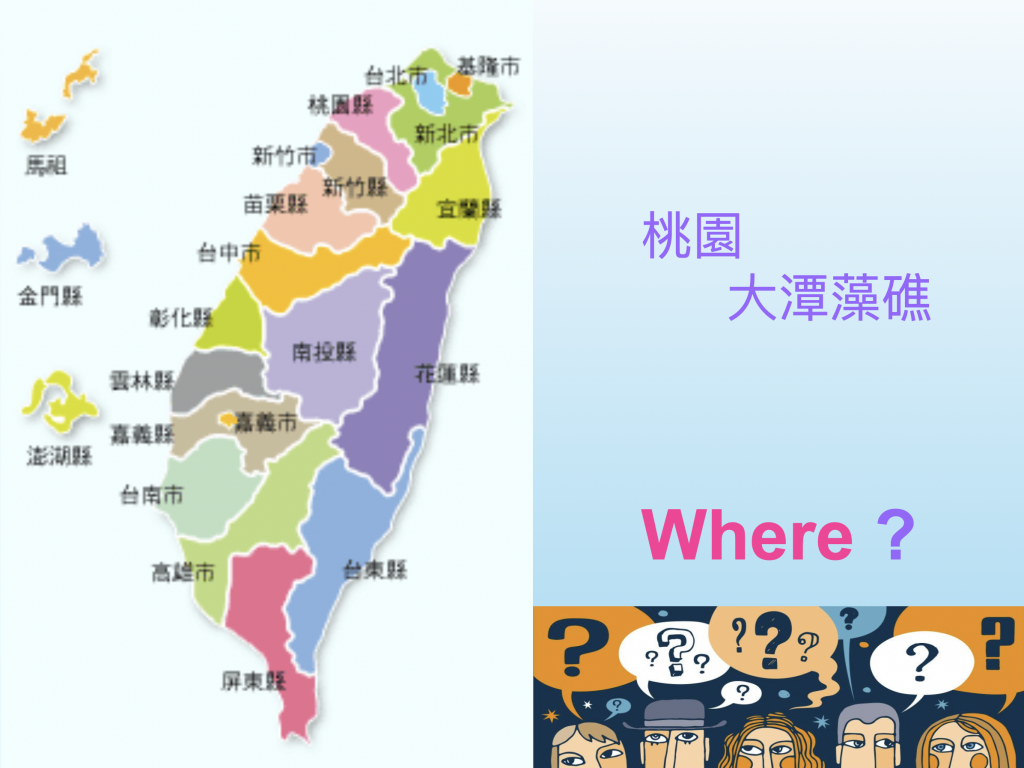 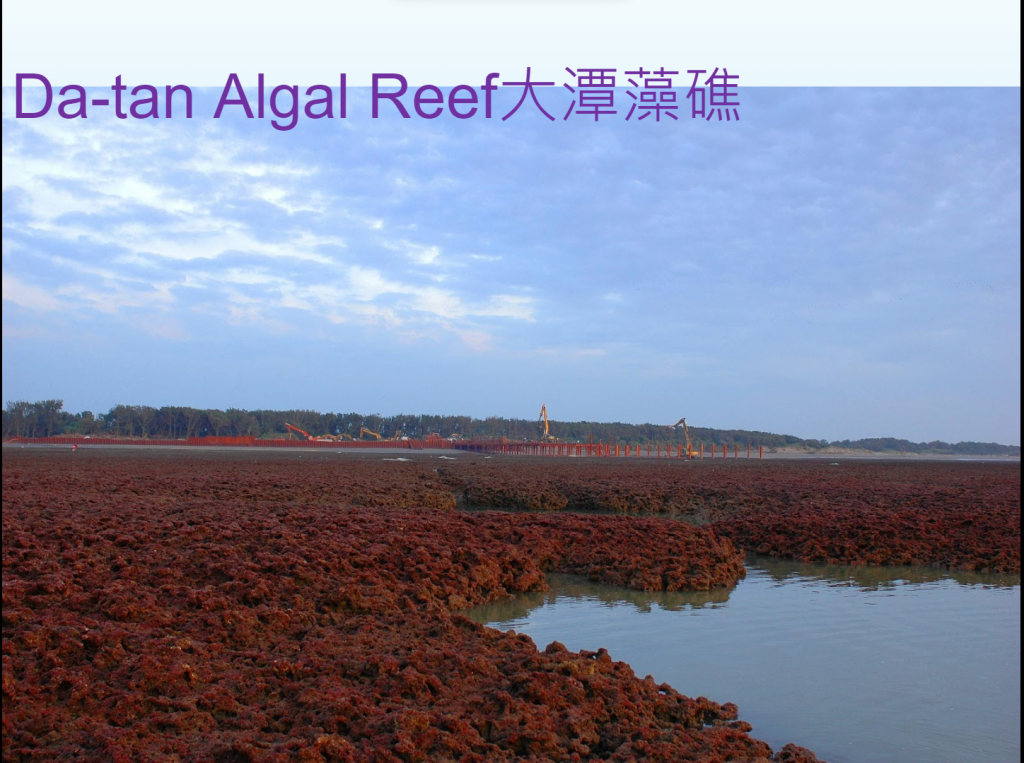 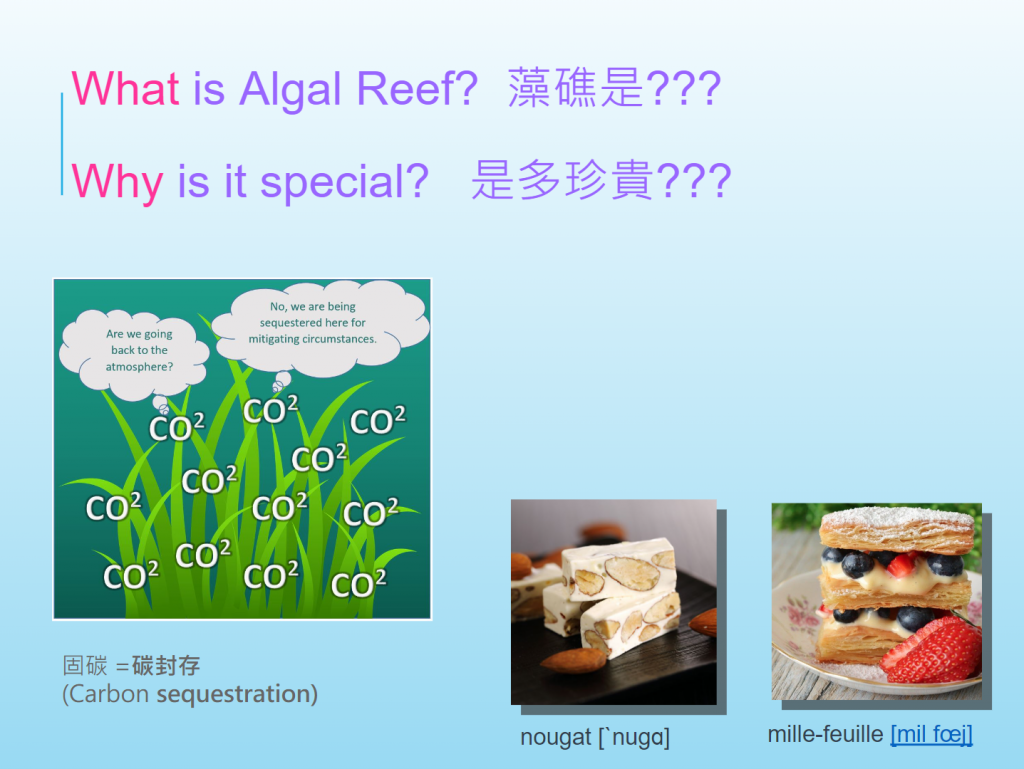 Slide 2-10 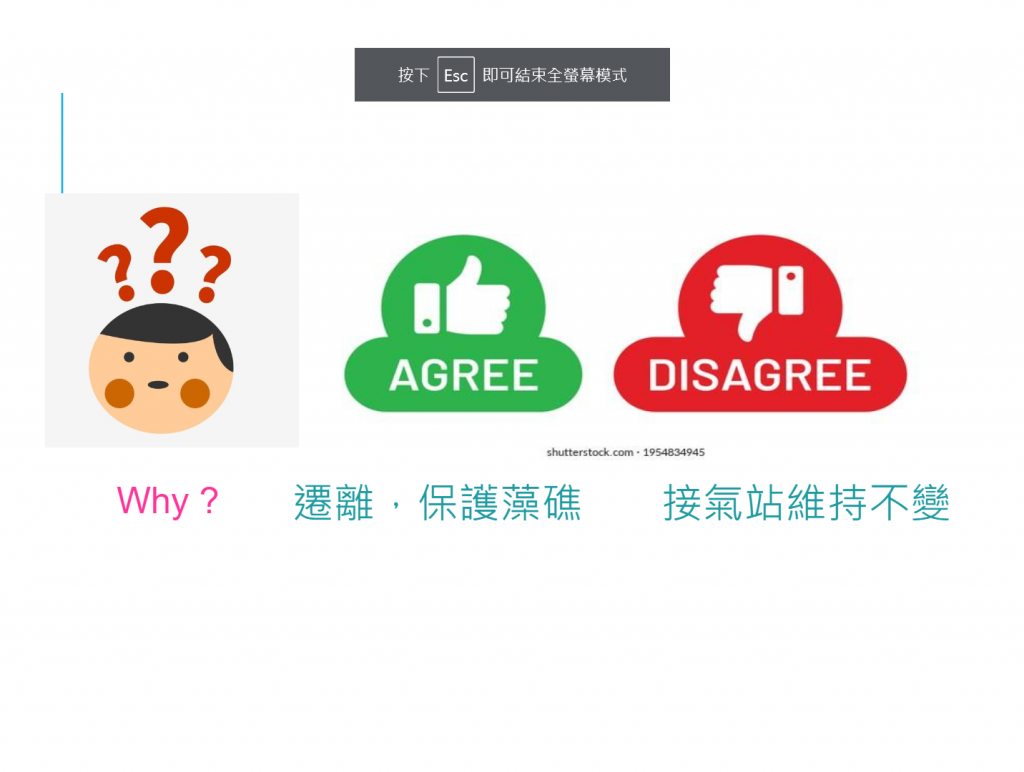 ballot paper 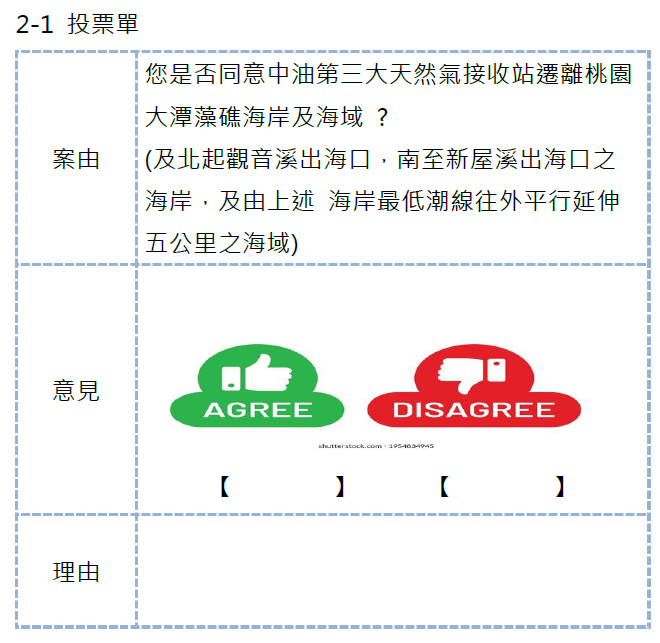 Slide 2-11~2-12 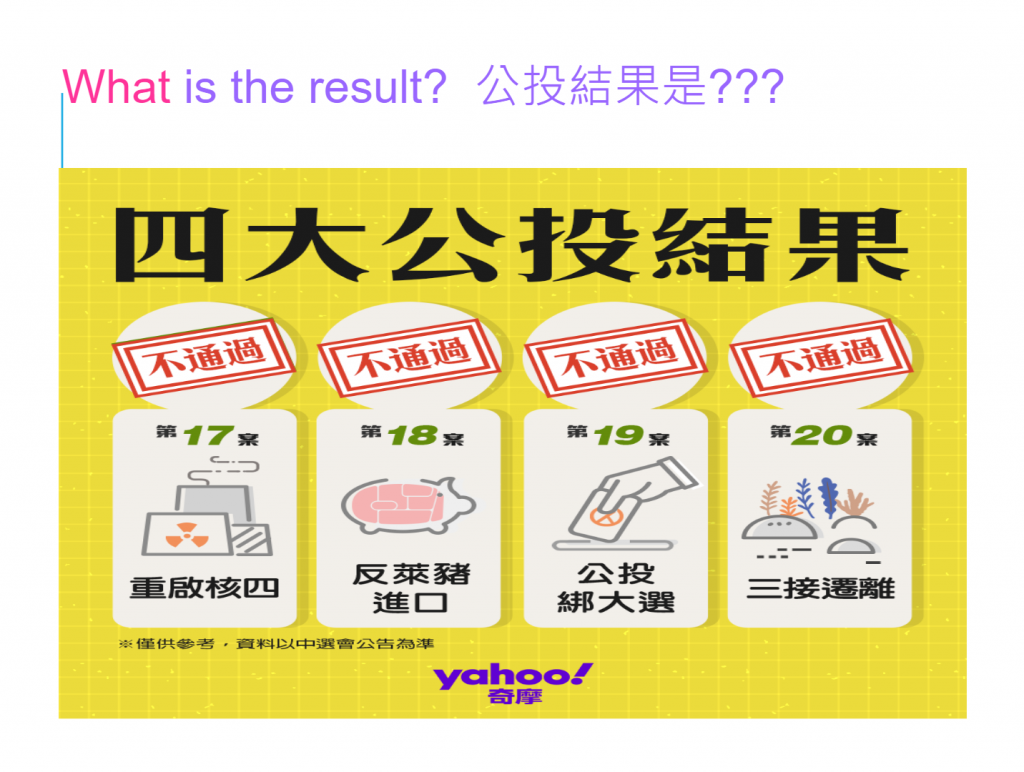 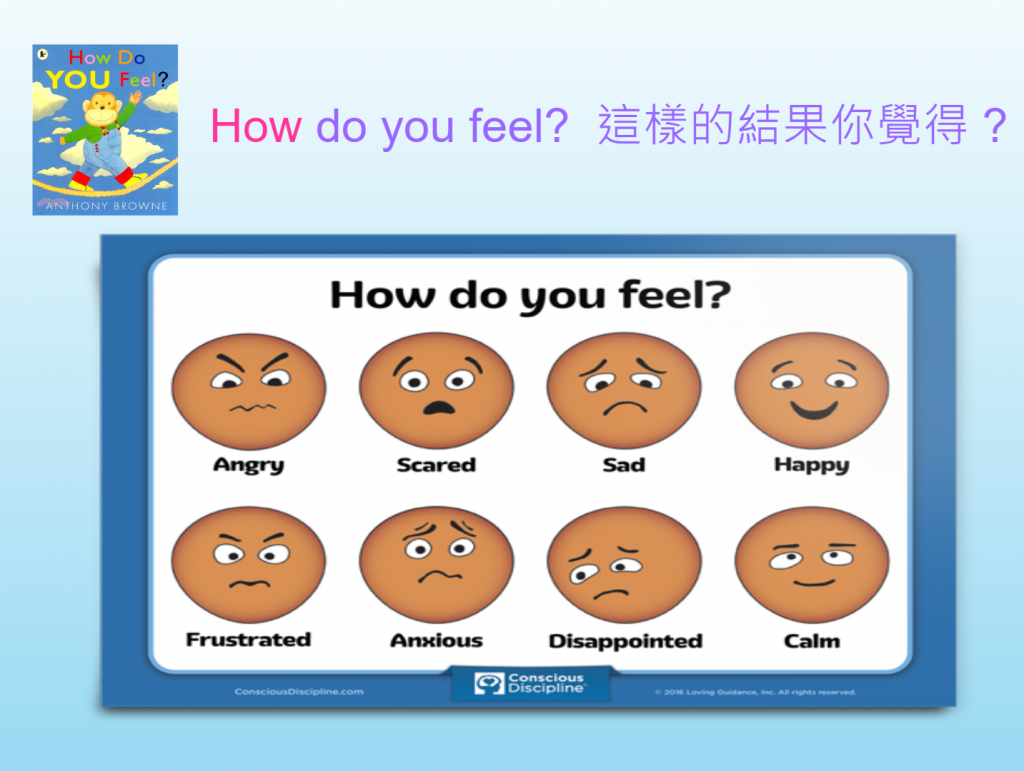 |
學生能於疑問句中辨別與理解6W 學生能瞭解公投的意義與認識公投議題 學生能閱讀與理解藻礁公投文案 學生能認識藻礁 學生能透過行動劇或正反意見陳述,理解與判斷藻礁保育與經濟發展之兩難 學生能模擬與操作投票流程 |
|
| 2-2太平洋彼岸--夏威夷垃圾島(2節) 一、準備活動:
※ T plays the film and leads S to figure out the ocean problems. ※ S may lead to the garbage problem. ※ T Q: Does Ciwidian face the same problem? Do you agree that we have garbage problems in our beach? ※ S may use the target sentences: Agree. / Disagree. 二、發展活動: (1) 更多國際報導:
https://www.youtube.com/watch?v=q6OEiFT30Pc 馬尼拉「垃圾浪」(1”51) https://www.youtube.com/watch?v=kNuJeQf3wOY 香港「垃圾村」(~2”16) https://www.youtube.com/watch?v=zlu0JPAypMM 太平洋垃圾島 ※ T plays the film about garbage patch, garbage wave, garbage village and leads S to figure out the ocean problems ※ S repeat the words:garbage patch, garbage wave, garbage village (2) 小組討論: 1. 垃圾來源 →圖示於圖畫紙 2. 垃圾種類 →圖示於圖畫紙 3. 可能的解決方案:天馬行空的、個人實際可行的 →演出 / 圖示於圖畫紙 ※ T leads S to think about where the garbage might come and to work out the possible solution ※ S do oral presenting with drawing or a short drama (T encourages S to use English words as more as possible) (三) 可行方案: 1. 影片播放: (1) 把人類的垃圾 還給你!垃圾怎減量?借鏡瑞典-李四端的雲端世界 (2”16~8”16) https://www.youtube.com/watch?v=zlu0JPAypMM 2) Great Pacific Garbage Patch (3”06) https://www.youtube.com/watch?v=GwluakE0p8o ※ T Qs what’s the surfing result of solution to the garbage patch? ※ S might recall by using a big rope floating on the sea to stop more garbage. ※ T plays the film to show how do people in Sweden and other countries do to reduce the garbage 2、綜合活動: (1) 永遠湛藍的海: 1. 影片:【洋食料理隨手做】塑肉餛飩湯 2. 說出我們能具體實踐的海洋保護行動 (1)學生發表 (2)閱讀:親子天下:愛海洋這樣做!友善海洋10大行動 http://www.parenting.com.tw/article/5074706 (3)國外的小孩怎麼做:Kids Can Save the Oceans https://www.youtube.com/watch?v=c8QyFRsnqc0 ※ 綠色和平--避免食用魚類 https://cloud.greentw.greenpeace.org/petition-oceans-cwfref=carousel&_ga=2.53593645.428901225.1642472327-1234414811.1642472327 ※ T plays more film and asks S to brainstorm the possible actions taking by the indiviual ※ S share their own possible ways ※ T concludes:each person can be a hero to protect the ocean (2) 預告: 1. 守護行動預告--淨灘 2. 讓水璉被看見--訪談「吉籟獵人學校」與「牛山呼庭」經營者 ※ T announces the clean-up beach activities and an interview next time |
Bilingual Slides Film Slide 2-15~2-16 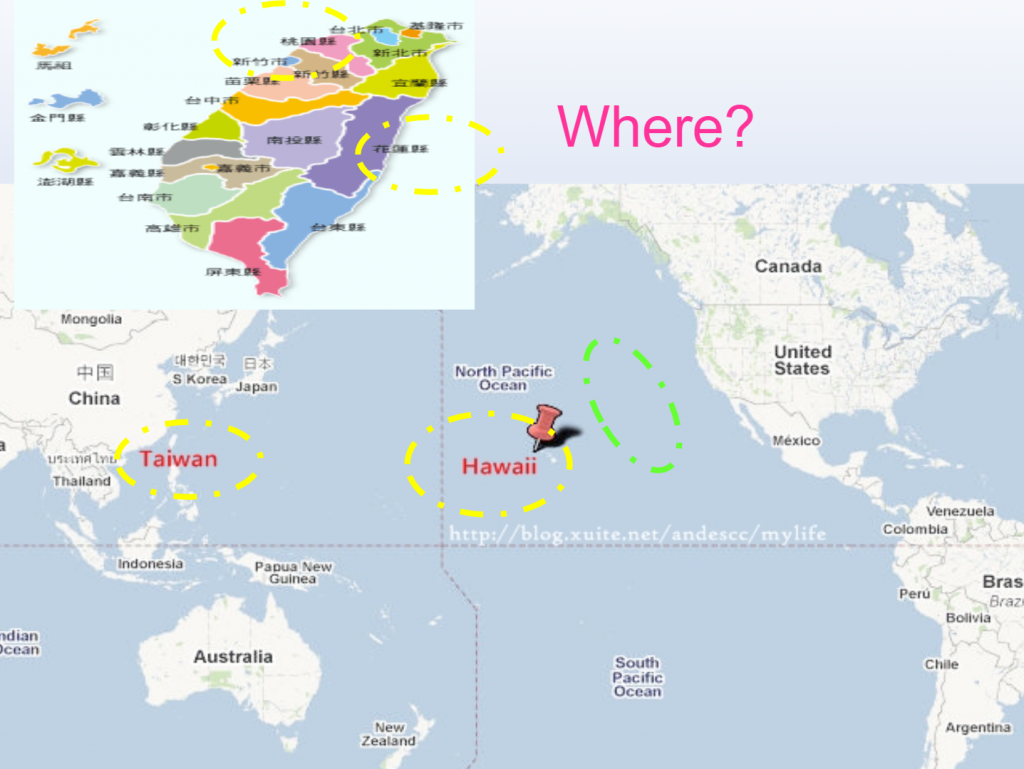 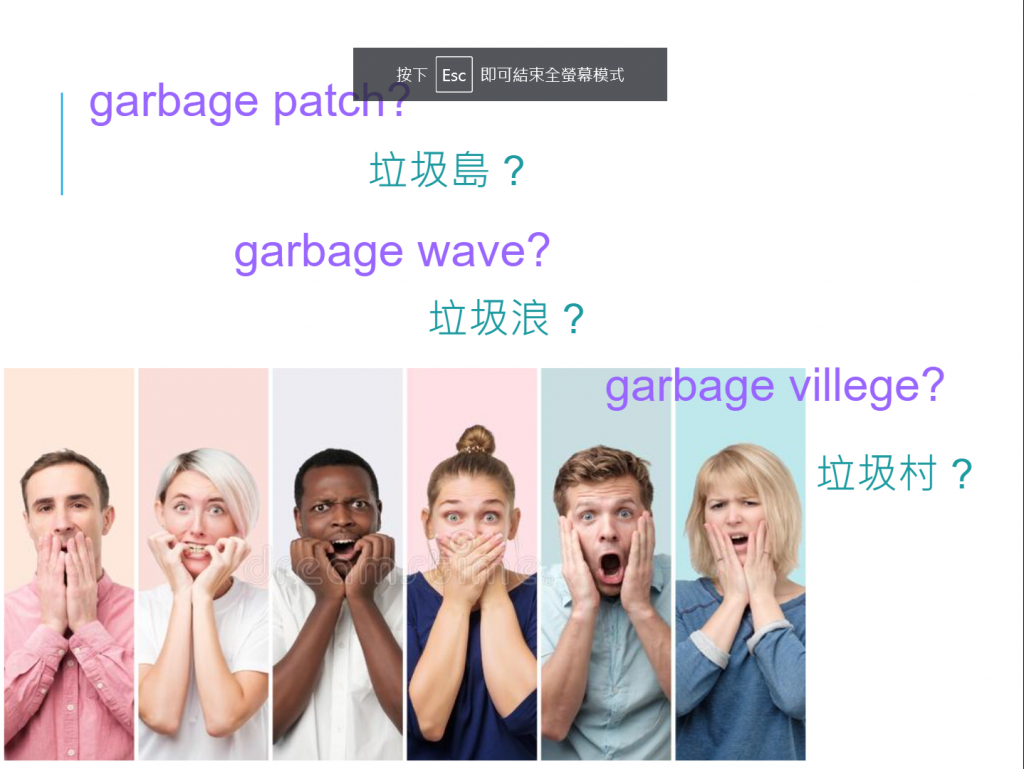 Slide 2-17 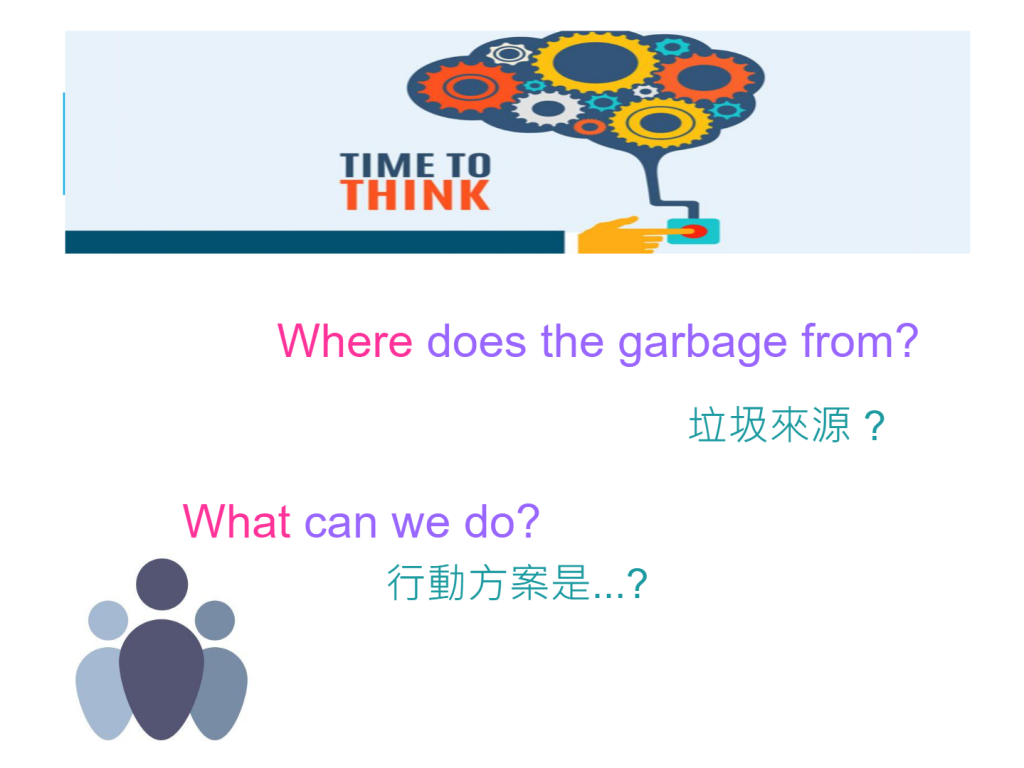 Film Film Slide 2-18~2-20 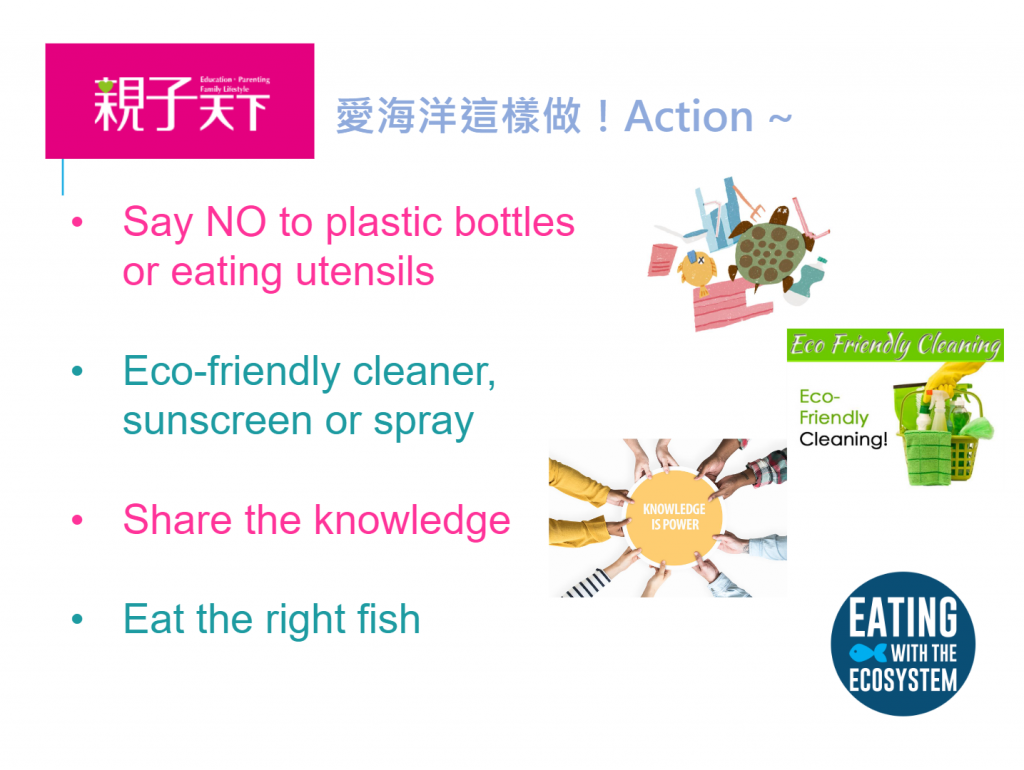 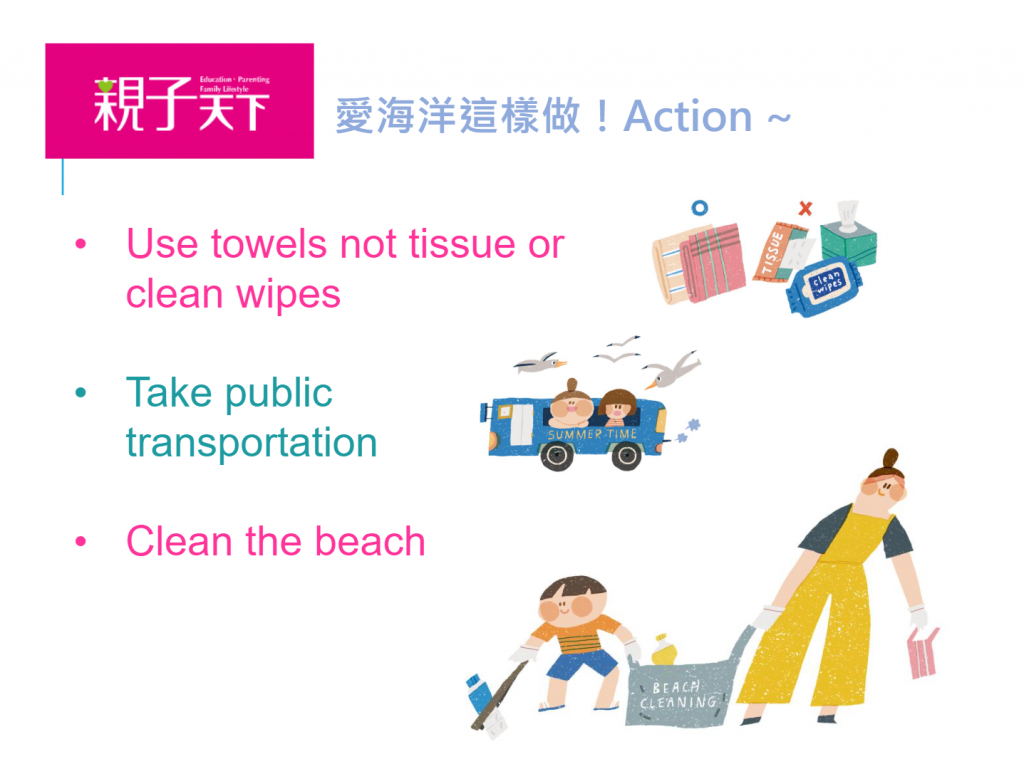 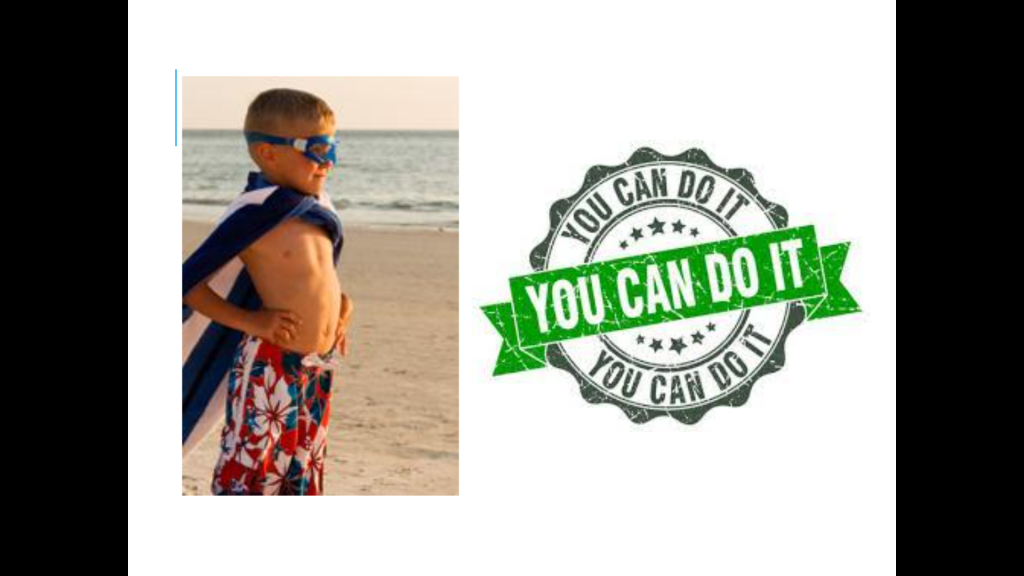 |
學生能回憶太平洋垃圾島問題 學生能提取影片傳達的海洋汙染訊息 學生能提取影片傳達的海洋汙染訊息 學生能透過小組討論設計出海洋汙染解決方式 學生能提取影片傳達的垃圾減量方式 學生能舉例說明個人可行的守護海洋行動 |
|
融入領域
語文、綜合活動、藝術
上課節數:8節
年級:年級
國際教育議題實質內涵
學生學習目標
總結性評量
現在行動,未來可期(8節)
| 教學節次 | 第8節 ~ 第15節 | ||
| 相關領域學習表現 (第二學習階段以上應包含英語文領域領綱) |
[綜合領域] 3d-II-1 覺察生活中環境的問題,探討並執行對環境友善的行動。 3d-III-1 實踐環境友善行動,珍惜生態資源與環境。 [藝術領域] 3-Ⅲ-5 能透過藝術創作或展演覺察議題,表現人文關懷。 [英語文領域] ◎ 1-Ⅱ-9 能聽懂簡易的日常生活用語。 ◎ 5-Ⅲ-4 能聽懂日常生活應對中常用語句,並能作適當的回應。 ◎7-Ⅲ-3 在生活中能把握機會,勇於嘗試使用英語 |
||
| 校訂國際教育 雙語學習內容 |
領域學習內容 Content | ||
| 1. 水璉在地觀光特色。 2. 淨灘行動與垃圾分類實作。 3. 海洋保護標語蒐集與設計。 |
|||
| 語言學習內容 Language of Learning | |||
| 目標字詞target words: tour guide notes :live in, a must go, awesome Beach cleanup checking list :fabric gloves, closed-toe shoes, bucket, tongs, sack / garbage bag, sun hat Sorting :trash、cans、glasses、plastic visual art works :body art, waste art, alphabets, save the ocean 目標句型target sentences: Tour Guide Notes : Hello, I am … We live in Shueilian. (Cidal Hunter School / Huting) is a must go in Shueilian. You can … there. It’s (cool / awesome) and it won’t let you down. Sorting :This one goes to trash / cans / glasses / plastic. visual art works:Save the Ocean |
|||
| 單元學習目標 (50~100字內) |
透過在地經營者訪談瞭解水璉海灘相關觀光活動,將其特色行程轉化為英語觀光導覽介紹。再透過淨灘與垃圾分類實踐海洋保護,並蒐集海廢英文字母拼組愛海宣言,以藝術形式發聲,喚起海洋保護意識。 | ||
| 教學步驟 | 引導做法 | 教學資源 | 認知能力 |
| 3-1歡迎到水璉觀光 (3節) 1、準備活動: (一) 照片展示:水璉以海廢創作的實景照片。 1. 閱讀地圖:確認水璉村景點位置。 2. 說說看這些作品在哪? ※ T shows the map of Shueilian /Ciwidian and shows some visual art works for S to identify the location ※ S uses the sentence to answer:It’s in… (二) 今日任務說明:
1. List out questions for interview. 2. Practice in groups for good questions. 二、發展活動:讓水璉被看見 (一) 訪談前的準備: 1. 分組:分2大組,各針對「吉籟獵人學校」與「牛山呼庭」做提問與訪談歸納 2. 提問內容討論與練習 3. 提問分類 ※ T lets S choose the interviewer and asks each group to discuss and list out questions for interview ※ S may use the following sentences: ★ What makes you special? ★ How do you connect with the ocean? ★ What action do you take to protect the ocean? (二) 人物訪談:訪談「吉籟獵人學校」與「牛山呼庭」經營者 1. 介紹與海的連結 2. Q & A 3. 個人筆記 4. 小組歸納與報告 ※ S take notes on the worksheet and have a group discussion to outline the interview 2、綜合活動: (1) 小組觀光導覽:以訪談內容做一段簡短的水璉觀光簡介 (1) 4人一組
(2) 預告下次活動:淨灘與收集海廢字母(2) 可繪圖輔助 ※ T leads S to finish the Tour Guide Notes ※ T may say: In the note, you write 1. “Hello, I am _______” (T points at the space on a demo note and says “your name”) 2. “We live in Shueilian.” 3. “Place is a must go in Shueilian.” (T takes out the map and points at the place, let S to look and spell the name of the place) 4. “You can ________ there.” (T demos the activity and lets S speak and spell it) 5. “It’s _______ and it won’t let you down.” (T demoes a series of adjective by flash cards, and then leads S to read and choose.) ※ S practice and present the Tour Guide Notes (full English if possible) ※ T previews next lession:beach cleanup and collect alphabets |
Bilingual Slides Worksheet |
學生能辨識地理位置與在地裝置藝術作品 學生能條列與歸納訪談問題 學生能筆記與摘要訪談內容 學生能做簡單的觀光導覽 |
|
| 3-2 還我美麗海灘 (2節) 1、 準備活動:淨灘前的工具準備與分組 (1) tools for cleanup 單字教學 (2) group practicing 小組練習 (3) matching game:
※ T introduces the beach cleanup tools:fabric gloves, closed-toe shoes, bucket, tongs, sack, sun hat (T demo these object on the hands ) ※ S repeat and memorize the words S may say: fabric gloves, closed-toe shoes, bucket, tongs, sack, sun hat” (S say and raise the object on their hands) ※ S play a matching game in groups to get all the tools ready 2、發展活動: (1) 車程 & 集合 (2) 海邊淨灘 (3) 垃圾回收分類 ※ T introduces words for sorting:Trash, Cans, Glass, Plastics ※ S sort the garbage and practice the sentence: This one goes to Trash / Cans / Glass / Plastics. 3、 綜合活動: (1) 預告下次活動:自拍拼圖—字母蒐集 (2) 回程 ※ T previews next lesson: collect alphabets and create a love ocean slogan |
Bilingual Slides Beach cleanup tools Checking list 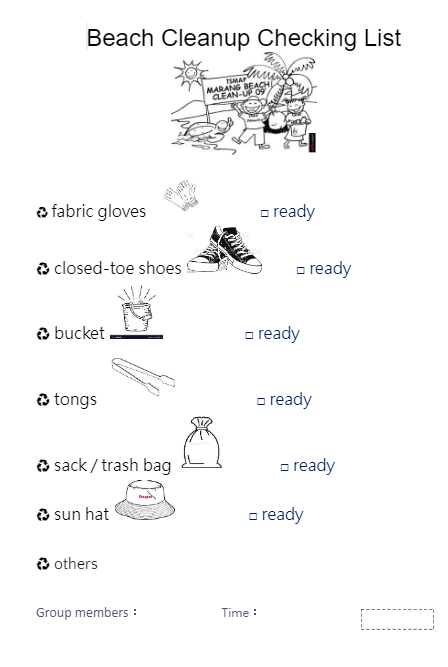 |
學生能辨識與檢核淨灘工具齊備 學生能正確分類垃圾 |
|
| 3-3海廢變黃金—海洋守護宣言 (3節) 一、準備活動: (1) 海廢也能變黃金:社區中隨處可見的海廢裝置藝術 (2) 藝術的形式:裝置藝術或者影像傳遞 ※ T reviews the visual art works in Shueilian village and explains that the art work can also be in the form of images 二、發展活動: (1) 從海廢到藝術創作
※ T introduces 2 artists and their art works:Rahic Talif & Liina Klauss (2) 海廢字母
※ S use tablets to take pictures of alphabets at the beach (3) 愛海洋宣言
B小組拼排與宣誓愛海洋宣言(含族語) ※ T encourages S to be a voice and leads S to make an body art declaration:SAVE THE OCEAN ※ S edit the alphabets poster by APP(PhotoGrid)or printed letters ※ S works in groups to brainstorm, google and edit a love ocean declaration and speak it out 三、綜合活動: 課程回顧與心得分享 |
Bilingual Slides Slide 3-10 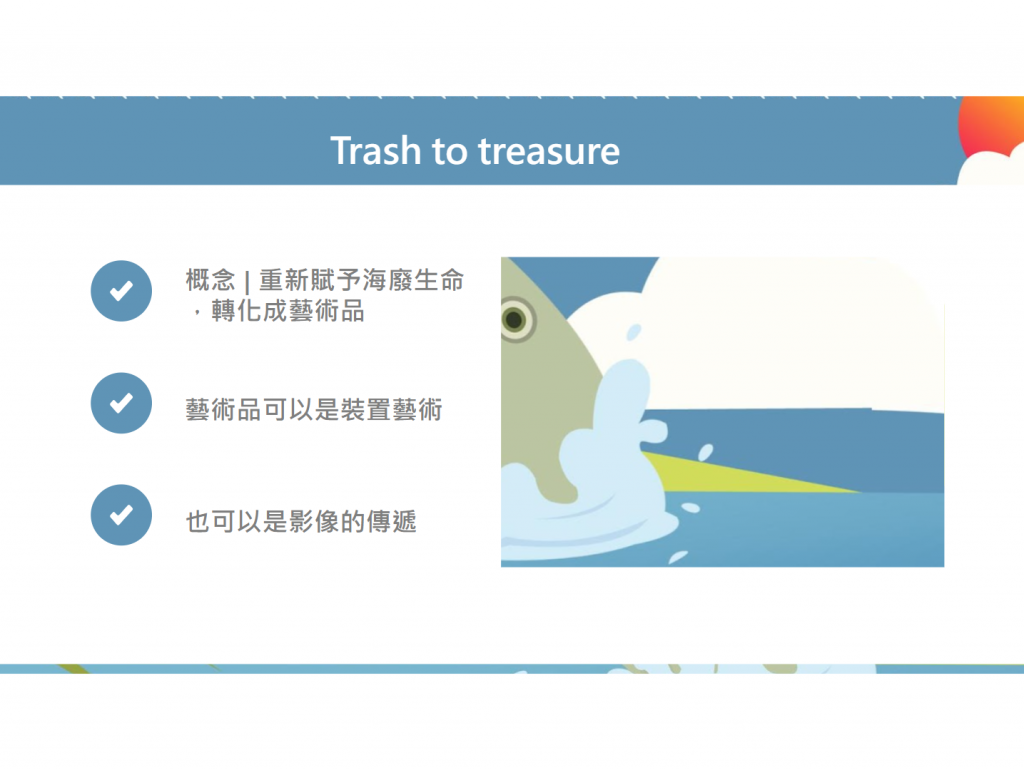 Slide 3-11~3-18 Slide 3-19~3-23 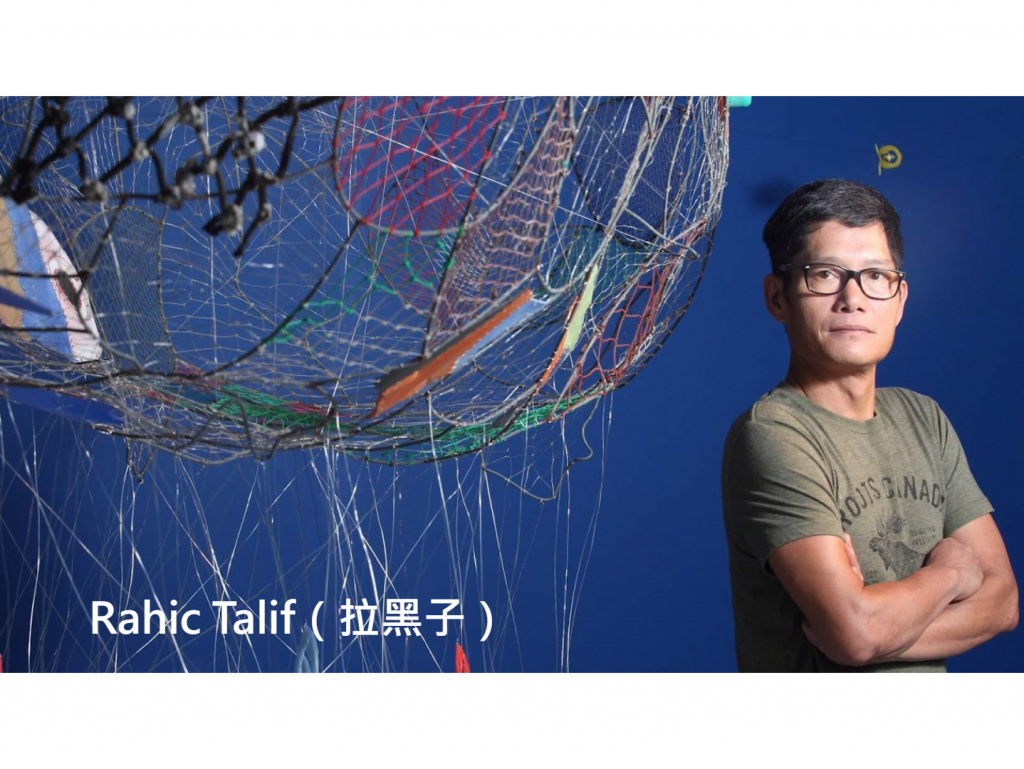 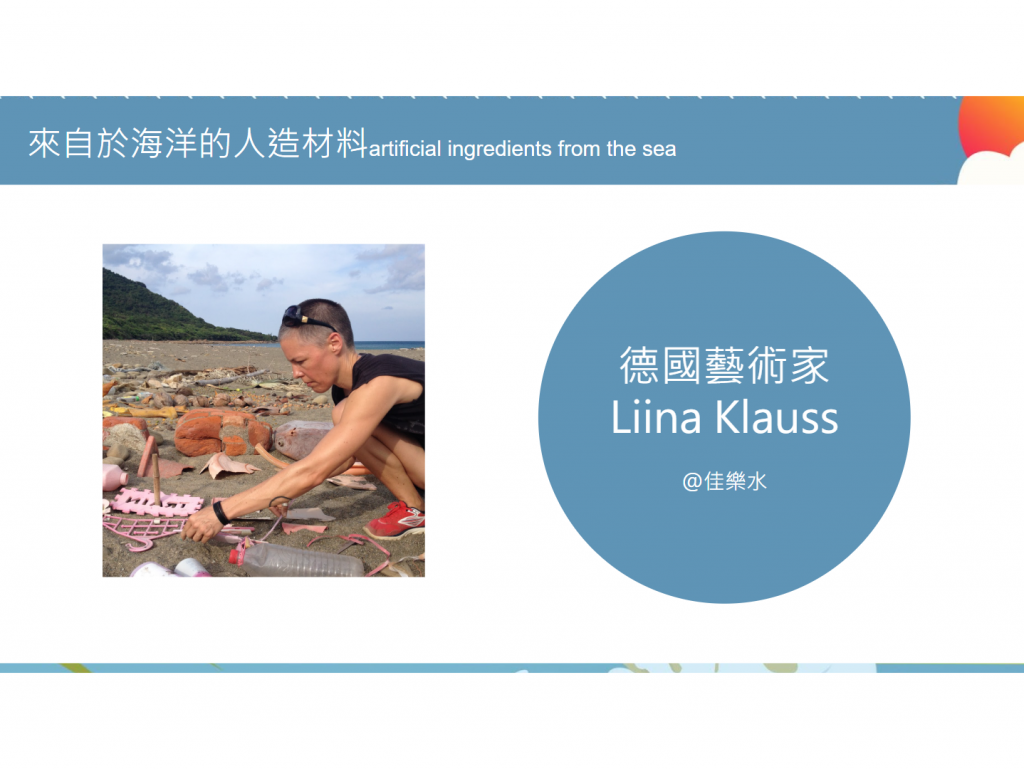 Slide 3-24~3-27 Slide 3-28 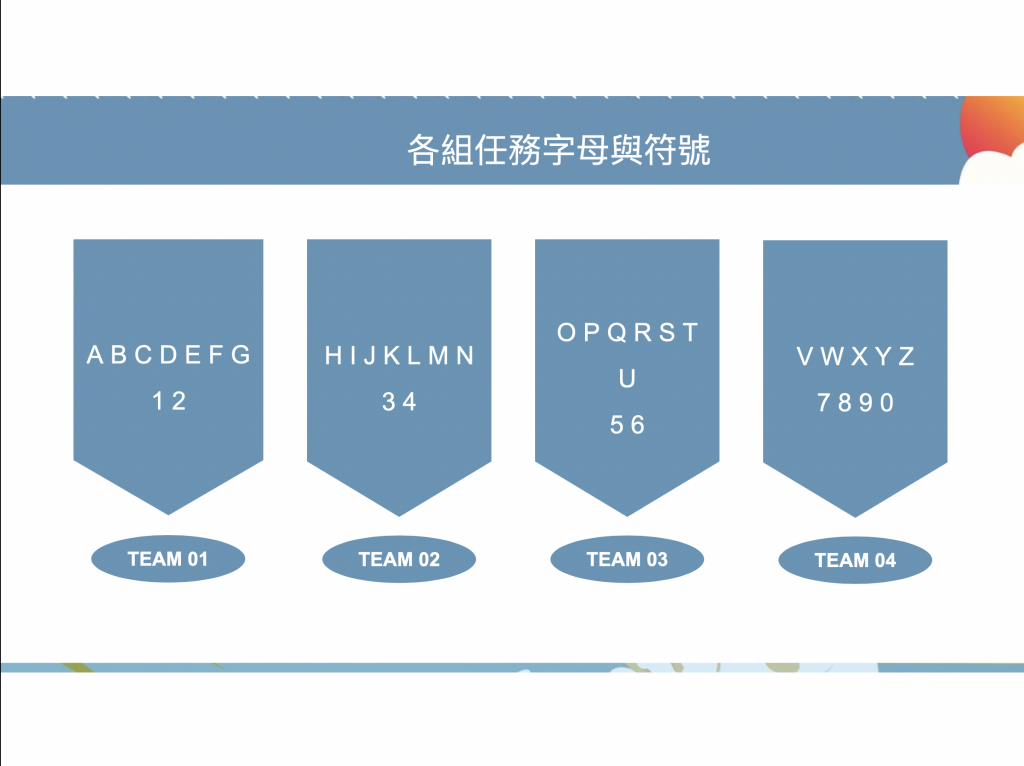 Slide 3-30~3-32 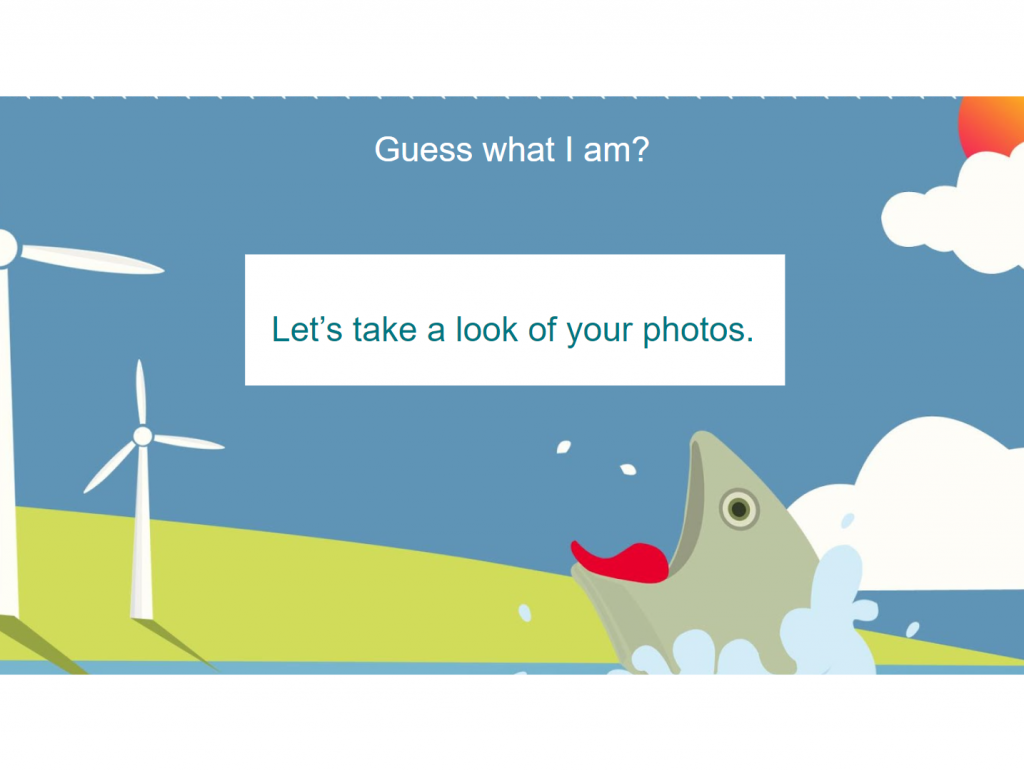 Slide 3-33~3-35 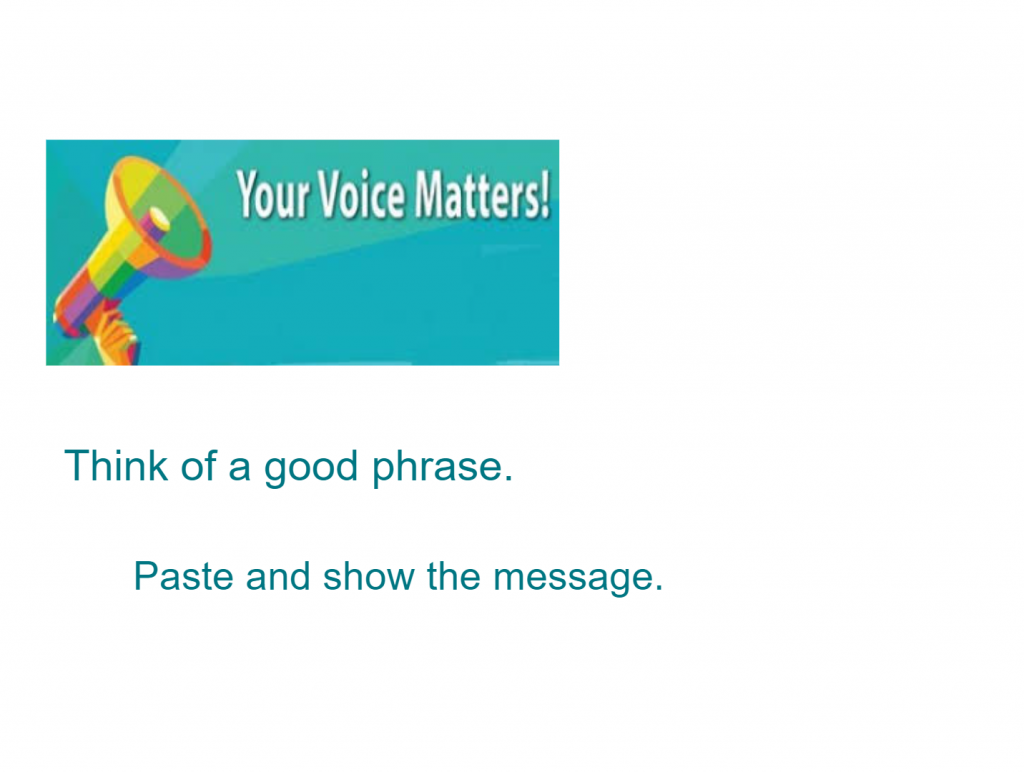 |
學生能認可海廢藝術創作並應用人體字母拼圖與海廢字母蒐集與拼排,傳達守護海洋心意 | |
